ALEXANDER THE GREAT 'IMPERATOR ULTIMUS' - IN PURSUIT OF MYTHS AND REALITY
Tamás Náray's painting cycle - 2025
The colors displayed on the screen may differ from the actual shades of the artworks or prints due to the differing properties/settings of monitors and video cards!
1. The Conception
- 40 x 40 cm
- Oil-gold-canvas
- 2025, Sitges/Barcelona
- This work is part of the cycle "Alexander the Great 'Imperator Ultimus' - in the footsteps of myths and reality"
- SOLD

The work evokes a story born on the border of myth and reality: the legend according to which Alexander was not only the son of the king of Macedonia, but also a descendant of Zeus, a demigod whose fate was determined by divine power from the moment of his conception.
At the center of the composition appears a glowing red arc – a crescent moon, which simultaneously symbolizes the seal of Alexander's father, King Philippos, and the womb of his mother, Olympias. The golden sphere fits into this: the embryo, the divine seed carrying the spark of Zeus within. The radiance of gold conveys the purity of new life and the light of chosenness.
The diagonally crossing golden lines pierce the picture field like spears, like lightning: the forces of divine conception, which pierce the red arc, fertilizing the female principle. The lightning of the sky here fixes the promise of immortality in the earthly world.
The deep blue background evokes the infinity of the universe: the stage where the story truly unfolds. In this dark, eternal space, the legend becomes reality: Philippos's dream, Zeus appearing in the form of a serpent, and the birth accompanied by a storm all condense into a single cathartic drama.
Red is the color of human desire and the body, gold is of sanctity and innocence, and blue is the color of the quietly resting eternity.
In this trinity, the mystery of Alexander's origin is formulated: a story that simultaneously carries human fear, divine predestination, and myth-making power.
2. Olympia's Dream
- 100 x 100 cm
- Oil-gold-canvas
- 2025, Sitges/Barcelona
- The artwork is part of the cycle "Alexander the Great 'Imperator Ultimus' – In Pursuit of Myths and Reality"
- SOLD

The vision of a strange night stands at the center of the painting: Olympia's dream, recorded for posterity by Plutarch. The queen saw herself as if she were spinning in an endless blue spiral, embraced by soft arms, when suddenly a storm arose and a golden lightning bolt struck her womb. The flame that sprang from this filled the room, but eventually died out – and she awoke lying on the ground. This dream was more than mere imagination: it foretold the fate of empires.
The spiral form dominating the composition draws the gaze in like a vortex. The spiral unfolding from the infinite blue embodies fate and destiny: a cosmic shape turning in on itself, in which Olympia's body and soul are also immersed. Inside the blue vortex, a radiant new moon shines – a symbol of birth and the future, proof that the arriving child bears no ordinary human fate. The new moon at the center is not only a symbol of the time of birth, but also a promise of growth and fulfillment. Illuminating from the depths of the vortex, it suggests: the child born in the light of the waxing moon stands before a great future.
The golden threads descending from the upper region are symbols of divine presence. These ethereal strikes evoke Zeus, who touches Olympia's womb as lightning, sealing her son's divine origin. The lightning's flaring flame filled the room in the dream – in the painting, this appears as vibrant red and orange streaks, breaking forth as fire raging on the edge of the blue.
On the outer curves of the spiral, the red and gold structures show the meeting of earthly desire and divine ordination. The tenderness of Philippos's arms, the human intimacy of the wedding night, appear only in the background: all is overridden by divine intervention, which ordains the birth of one of history's greatest figures.
“Olympia's Dream” simultaneously carries the triad of human sensuality, divine revelation, and the calling order. The spiral, the lightning, and the moon together depict the birth of an entire era.
3. Flames of Ephesus
- 100 x 100 cm
- Oil-gold-canvas
- 2025, Sitges/Barcelona
- This work is part of the cycle "Alexander the Great 'Imperator Ultimus' - In the footsteps of myths and reality"
- SOLD

The expressive power of the work truly sets the canvas ablaze. The composition is divided into two main units: the left, golden structure, evoking the sacred, timeless purity of the temple, and the right side's hypnotic waves of red and deep blue, symbolizing destruction and fate. There is no harmonious transition between the two—on the contrary: the meeting of the two forces creates a sparkling, explosive energy.
The starting point of the painting is a historical moment: in 356 BC, on the night of Alexander the Great's birth, the Temple of Artemis at Ephesus, one of antiquity's most marvelous sanctuaries, caught fire. According to the Persian magi's interpretation, the fire was no accident: someone was born who would bring destruction to empires and peoples, and redraw the map of history. Legend has it that the temple could burn because its goddess was assisting at Alexander's birth—thus, the child's arrival became the shadow of a sacred place's destruction. This mythical symbolism echoes in every vibration of the canvas.
The red field on the right—the color of living, raging flames—can also be read as an attack against divine order: human birth and the destruction of the divine temple overlap. Blue shadows emerge from the flames: the ash left behind by the fire, the hue of mourning and the tragedy of the future. The blue stretching into infinity warns: the flame is not only light, but also inevitable destruction.
On the left side of the work, as seen from the front, the fragmented gold and white surface evokes the temple's purity, as well as the presence of Artemis. The gold preserves the last remnants of sanctity, and the red square embedded in the center of the composition—the motif of the altar— protects the sacred space: everything remains in the memory of history.
The work is essentially an allusive visual prophecy: the left side is the divine order, protected by the sanctity of the altar, while the right side is historical violence. The birth of Alexander is a turning point in an era—a fire that changes everything, but also consumes everything.
The work simultaneously documents and foretells: it recalls one of the most dramatic nights of the past, while awakening the question in the viewer: does every great birth also carry the promise of destruction?
3.1. The Fire
- 50 x 50 cm
- Oil-gold-canvas
- 2025, Sitges/Barcelona
- This work is part of the cycle "Alexander the Great 'Imperator Ultimus' - In the footsteps of myths and reality"
- SOLD

In the work titled "The Fire," myth and sacred vision merge into a single, vibrant surface. The painting captures not only the destructive and creative nature of the flame, but also one of the primordial elements of the universe: that divine force without which neither birth, nor destruction, nor transformation is possible.
The composition is dominated by two poles: the gilded surface on the left radiates timeless, unbreakable stability, from which the crimson-red square—the absolute—rises like an altar, symbolizing sanctity and judgment. This square is a recurring motif in several cycles, embodying the divine standard placed above human aspirations.
However, on the right side, the fire rages: everything dissolves into shades of red, orange, and glowing hues, while the bursts of blue and white evoke the possibility of purification, striving towards the sky, and ascension. The vertical forms leap skyward like tongues of flame.
The painting simultaneously evokes the interiors of sanctuaries, where the flames of sacrifices to the gods burned, and those military camps where Alexander's soldiers gathered around the fire—as symbols of conquest and destruction. "The Fire" is thus not merely a natural element, but a universal metaphor for history, myth, and human destiny.
The canvas's vibrant energy speaks of how all power, all greatness, and every empire is measured by fire: it rises in the light of divine force, and in the same light falls to dust.
4. A King is Born
- 100 x 100 cm
- Oil-gold-canvas
- 2025, Sitges/Barcelona
- The artwork is part of the cycle "Alexander the Great 'Imperator Ultimus' – In Pursuit of Myths and Reality"
- SOLD

The artwork is an allegory of beginning and destiny: it depicts the God-ordained dimension of the birth of a ruler stepping onto the world stage. Alexander's coming into the world already transcended human fate in the legend of his conception, and this work is a painterly formulation of a prophecy interwoven with celestial powers.
The golden and bronze, metallically cold layers dominating the picture plane evoke the solidity of the earth and the material world of the continents, which the ruler later united through his conquests. In contrast, the lapis lazuli and cobalt blue stream bursting from the lower part of the composition symbolizes the seas: a world without borders, which during the campaigns was unified into an empire from the known world.
The central element of the painting is the crimson-red square: a sacred symbol that evokes both the sanctity of the altar and the universality of faith. This dynamically traversing square in the picture plane appears as a force that rises above religions, marking the meeting of divine ordination and human destiny.
The white, opalescent, cloud-like bands descending from the upper regions of the composition represent the purity of souls: the innocence of those souls who – by virtue of their contract with the heavens – accept their fate, even if it means losing their purity. These beams of light simultaneously convey the promise of heaven and the burden of fate.
The rich gold coating and the countless shades of red fill the unmoving blue timelessness below with dynamism. Divine energy thus engulfs and claims the sparkling crimson-red square at the center of the picture plane. The trinity of red, gold, and blue carries the fullness of birth: blood, the earthly world, the divine dimension, and the path of conquest.
The painting is at once ethereal and human, mythical and historical. The moment of birth is also the birth of an era: that of Hellenism, which sprang and blossomed from Alexander's short but transformative life.
5. The Secret of Olympia
- 81 x 70 cm
- Oil-gold-canvas
- 2025, Sitges/Barcelona
- The artwork is part of the cycle "Alexander the Great 'Imperator Ultimus' – In Pursuit of Myths and Reality"
- SOLD
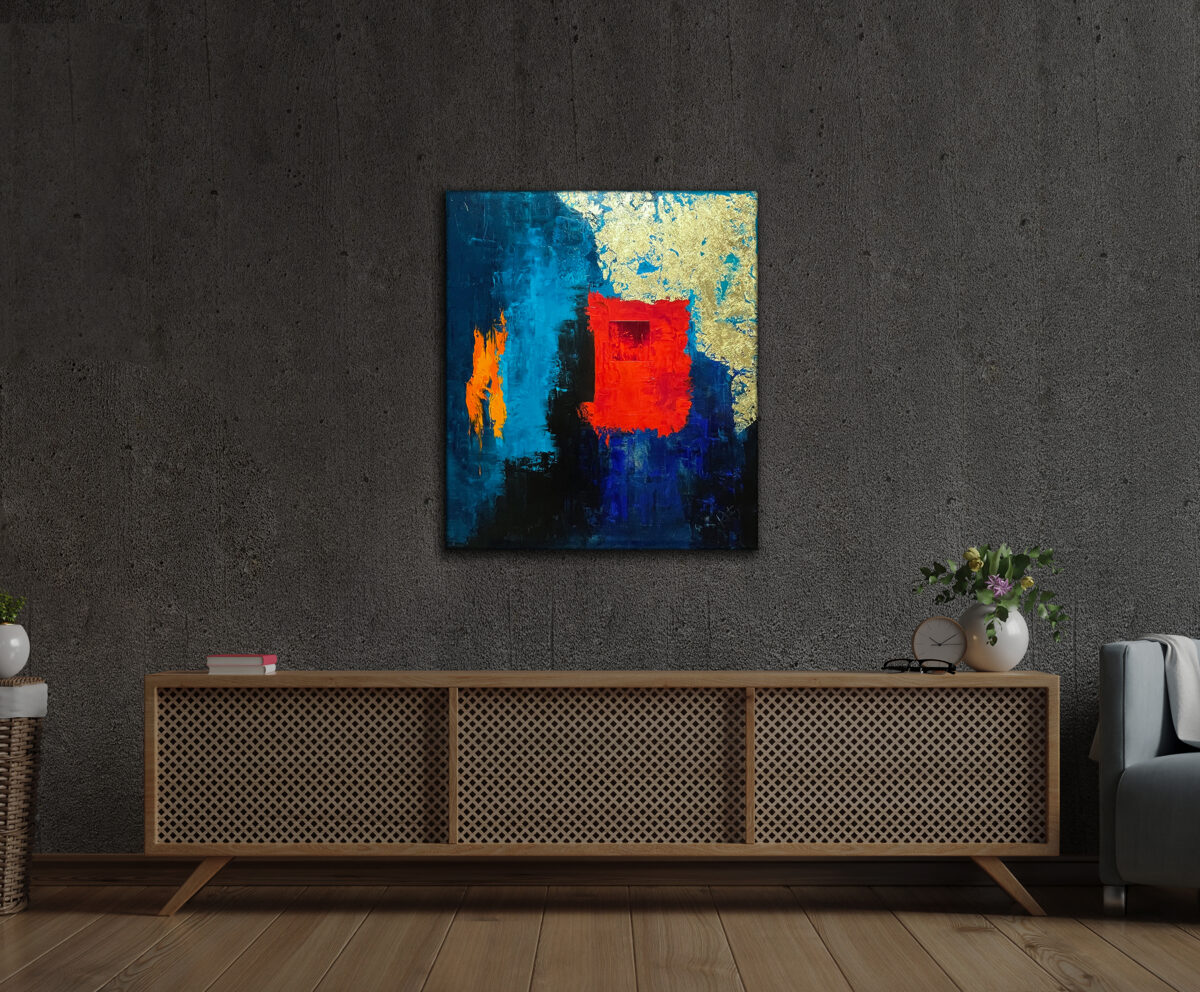
The painting emerges from the fabric of legends and silence. Olympia, who in both life and death remained a woman of mysteries, never answered the question that would have determined the future of her son and his empire: was Alexander truly the son of Zeus?
According to tradition, even Roxana questioned her about this while trying to save the young Alexander IV during their escape, but Olympia took the secret with her to the grave.
The closed composition of the canvas itself embodies the secret: a space constructed from interlocking and impenetrable, quadratic forms, at the center of which the red square shines – the sanctity of the altar, the seal of divine origin. This square simultaneously refers to the power of invisible gods and the unspoken truth that never became certainty.
In the upper right part of the painting, pierced golden surfaces appear, like a theater curtain that opens only slightly, never fully revealing what lies behind. Behind the cracks of the fractured texture, turquoise colors shimmer: the field of hidden truth, accessible only through myths and beliefs. The symbolism of the golden curtain appears here for the first time in the cycle: the veil between gods and mortal humans, which only legends can lift for a fleeting moment.
The dark, deep structures of the lower region carry the coded fate. From below, a gigantic force breaks forth, signaling the relentless logic of history: the light of myths is always accompanied by shadow, and the promise of glory is always threatened by the possibility of destruction.
Thus, “The Secret of Olympia” simultaneously refers to the mystery of birth, the divine origin of power, and the merciless presence of fate. Silence and secrecy are present in every color layer of the painting: history does not provide a clear answer, only symbols that hint at the unspeakable.
6. The Prophecy
- 93 x 72 cm
- Oil-gold-canvas
- 2025, Sitges/Barcelona
- This work is part of the cycle "Alexander the Great 'Imperator Ultimus' - In the Footsteps of Myths and Reality"
- SOLD
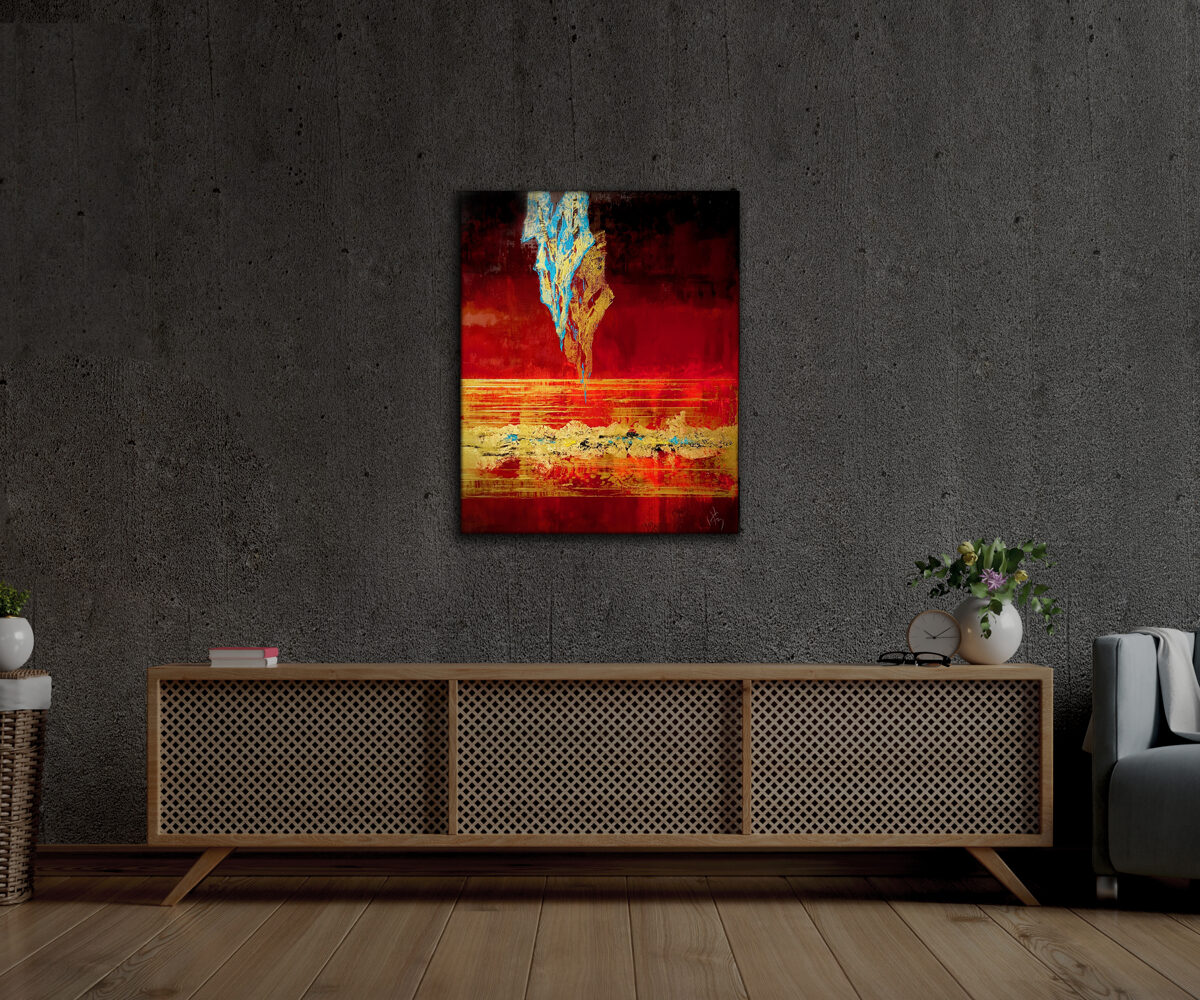
The deep, cauldron-like glowing red of the composition is the smoldering space of the subconscious – the place where dreams, memories, and prophecies intertwine.
The turquoise-gold cultic form dripping down from the upper part of the painting evokes both a totem and a spirit: the wolf who appears in Alexander's dream to reveal the secret of the future to him. This figure does not float as an earthly being, but above time and space, torn from the celestial tapestry itself.
The golden stripe – fragmented, yet continuous – stretches across the horizon of the painting like a timeline. On this “film strip” unfolds the series of conquests, the expansion of the empire, the opening world, which according to the prophecy will belong to the young king. In the red undertone lies the promise and price of blood, the fever of haste: Alexander knew his time was limited, and in the meaning of his fate, he had to turn every minute into a battle.
The structure of the painting is like the prophecy itself: concise, declarative, and irrevocable. The turquoise-gold totem figure dripping from the upper region is not only a fearsome vision, but the moment when fate becomes tangible – and there is no turning back.
7-8. The Question (Diptych)
- 2 x 60 x 60 cm
- Oil-gold-canvas
- 2025, Sitges/Barcelona
- The artwork is part of the cycle "Alexander the Great 'Imperator Ultimus' – In Pursuit of Myths and Reality"
- SOLD

These two canvases – placed side by side – lead the viewer to an imaginary courtroom. The witnesses and accused of the past stand before the observer.
On the right panel, the blows of history swirl: whirling, here and there unraveling gold and crusty, rust- and earth-brown surfaces, between white, sharp lines: the sharp blades of fate and destiny cut into the fabric of time. Here echoes (336 BC) Aigai, the amphitheater where the people gathered to see and greet their ruler. Philip, the Macedonian king, approached the arena with wounded steps, when Pausanias, his own bodyguard, began to run towards him and stabbed a dagger into the king's chest.
The left panel's darker, deeper tones preserve the shadow of the crime committed. The upper red field, a sky filled with blood, weighs heavily on the composition. Here, the narrative is no longer about the facts, but about the question that has haunted historians for two thousand years: is it possible that Alexander, one of history's brightest conquerors, was complicit in his father's death?
Thus, the diptych is a double report: the first canvas presents the sweeping force of the moment of the act, the second the uncertainty, the suspicion, and the grave, unanswered question of history. The symbol of the infinite cycle of time also appears in the upper right region of the composition, this time in the sign of judgment: gold as divine reckoning, and the white, sharp lines as the declarers of preserving grace. Between the two panels stretches the invisible gap where certainty breaks, and where art – like historiography – can only fill the void with conjectures.
9. The Time Traveler
- 93 x 72 cm
- Oil-gold-canvas
- 2025, Sitges/Barcelona
- This work is part of the cycle "Alexander the Great 'Imperator Ultimus' - In the Footsteps of Myths and Reality"
- SOLD

The canvas, glowing in golden light, opens up before the viewer like a cosmic explosion: metallic gleams and sparkling textures shade the upper region: a time gate opens in space. The golden arc curving from the left, besides symbolizing time and its infinite, self-returning nature, also evokes the eternal orbits of celestial bodies, while the sharp red rays bursting from the upper right corner penetrate the present from another dimension. Below, at the lower edge of the painting, white edges collapse from the grayish-black depths – the chasms of time, across which only a few may step.
This painting embodies a peculiar fiction: what if Alexander – one of history's greatest conquerors – was actually a time traveler? What if he arrived from the future, with knowledge and visions that surpassed his era by centuries. For what he traversed and conquered in his short thirty-three years could not be easily covered even by plane today – let alone fighting life-and-death battles along the way.
In the central line of the composition, there is a square shape enriched with vivid turquoise pigments, within which a red fragment, piercing with annihilating will, marks the trace of an alien technology: a space-time coordinate marking, recording the destination of the journey.
The painting is both a tribute to myth and a play with the impossible: the golden lights represent divine chosenness, the red rays the heat of battles, and the depth carries the terrifying risks of the unknown flow of time.
“The Time Traveler” is thus not only a reinterpretation of a historical figure, but also a thought experiment about whether the great conquests might be fueled by forces not of this world.
10. Time Loop
- 80 x 80 cm
- Oil-gold-canvas
- 2025, Sitges/Barcelona
- The artwork is part of the cycle "Alexander the Great 'Imperator Ultimus' – In Pursuit of Myths and Reality"
- SOLD

The human brain is coded: it is able to think in boundaries and a single timeline, where everything leads from the past through the present to the future. But what happens if time fractures, or is destined to unfold in a spiral cycle, in repetitions, or in units we cannot decode?
Tamás Náray's painting, 'Time Loop', raises this question in the mirror of Alexander's life path. After all, how do we deal with the paradox that in his brief, only thirty-three years of earthly existence, he condensed deeds that transcend a human life? Where did he come from, what forces shaped him, and did he truly walk among us as the son of the gods?
At the center of the canvas, the sanctity of the altar shines, as the fixed point of the creation story, connecting heaven and the earthly world. From here descends the black-blue-red stripe: the somber black of fate, the blue of divine ordination, and the blood-red of sacrifices entwined, carrying the condensed essence of Alexander's journey.
On the left, deep within the painting, an ultrasound image emerges: the silhouette of a female womb with the outline of a fetus inside. This motif simultaneously refers to the secret of beginnings and to the divine legends surrounding his birth, which hinted at Zeus's presence in Olympia's bedchamber. The golden crescent moon arching above is the symbol of divine will, which marked Alexander's path from the moment of his birth.
On the right side of the picture, the broken gold and white structures appear in layered planes, like the time layers of earthly existence, which flow unstoppably, yet always lead to the same endpoint. The structure of the painting suggests: time is not linear, but circular, and in this circle, Alexander's figure appears again and again, though with different meanings for each era.
Thus, the work is both a transcendent vision and a human drama of fate. A vision that there are lives so extraordinary that they can only truly be understood in a recurring time spiral.
11. "My son, seek a kingdom more worthy of yourself, Macedonia is too small for you!"
- 50 x 50 cm
- Oil-gold-canvas
- 2025, Sitges/Barcelona
- This work is part of the cycle "Alexander the Great 'Imperator Ultimus' - in the footsteps of myths and reality"
- SOLD

The painting entitled “My son, seek a kingdom more worthy of yourself, Macedonia is too small for you” is one of the most lyrical yet dramatic pieces in Tamás Náray’s '‘Alexander the Great - Imperator Ultimus’ series: a visual embodiment of a prophecy, in which the boy’s fate transcends earthly boundaries and ascends into divine dimensions.
The upper region of the canvas is illuminated by golden and yellowish lights, the sky unfolds before us – this is nothing but the timeless light of prophecy, arriving as a fatherly word, yet as a divine message. The gold is a sign of chosenness, and the radiance of infinite possibilities. The purple spot flashing on the right side is the color of passion, the pulsing blood and power: the promise of an empire that accompanied Alexander throughout his life.
Below, in the lower band of the canvas, the deep red stripe flows down as a continuous curtain of blood, like a calling or decree, which determines the price of the path: conquests are always accompanied by sacrifices. From behind the red, translucent golden structures emerge: the promise of the future becomes visible precisely through blood and struggle. In the center of the composition, a faintly emerging mountain range suggests: before the boy enclosed within the borders of Macedonia, the mountains and peaks of the world rise, which he must conquer and overcome.
The painting unfolds as a theatrical spectacle: the clash of colors creates dramatic tension, the heavenly prophecy and earthly reality are revealed to our eyes at the same time. The combination of gold, red, and purple is not only an aesthetic harmony, but a formula of fate: the meeting of divine promise, blood sacrifice, and the intoxication of power.
This work captures the mythical core of Alexander’s birth and youth: the moment when the boy is no longer a mere human, but part of a greater order. The paternal message – “seek a kingdom more worthy of yourself” – is not merely advice, but destiny: the path designated by the gods, from which there is no return.
This piece of the '‘Alexander the Great - Imperator Ultimus’ series thus becomes the iconic imprint of beginnings: the proclamation of fate, where light, blood, and gold together mark the path of one of history’s greatest rulers.
12. The Other Kingdom
- 80 x 80 cm
- Oil-gold-canvas
- 2025, Sitges/Barcelona
- This work is part of the cycle "Alexander the Great 'Imperator Ultimus' - in the footsteps of myths and reality"
- SOLD
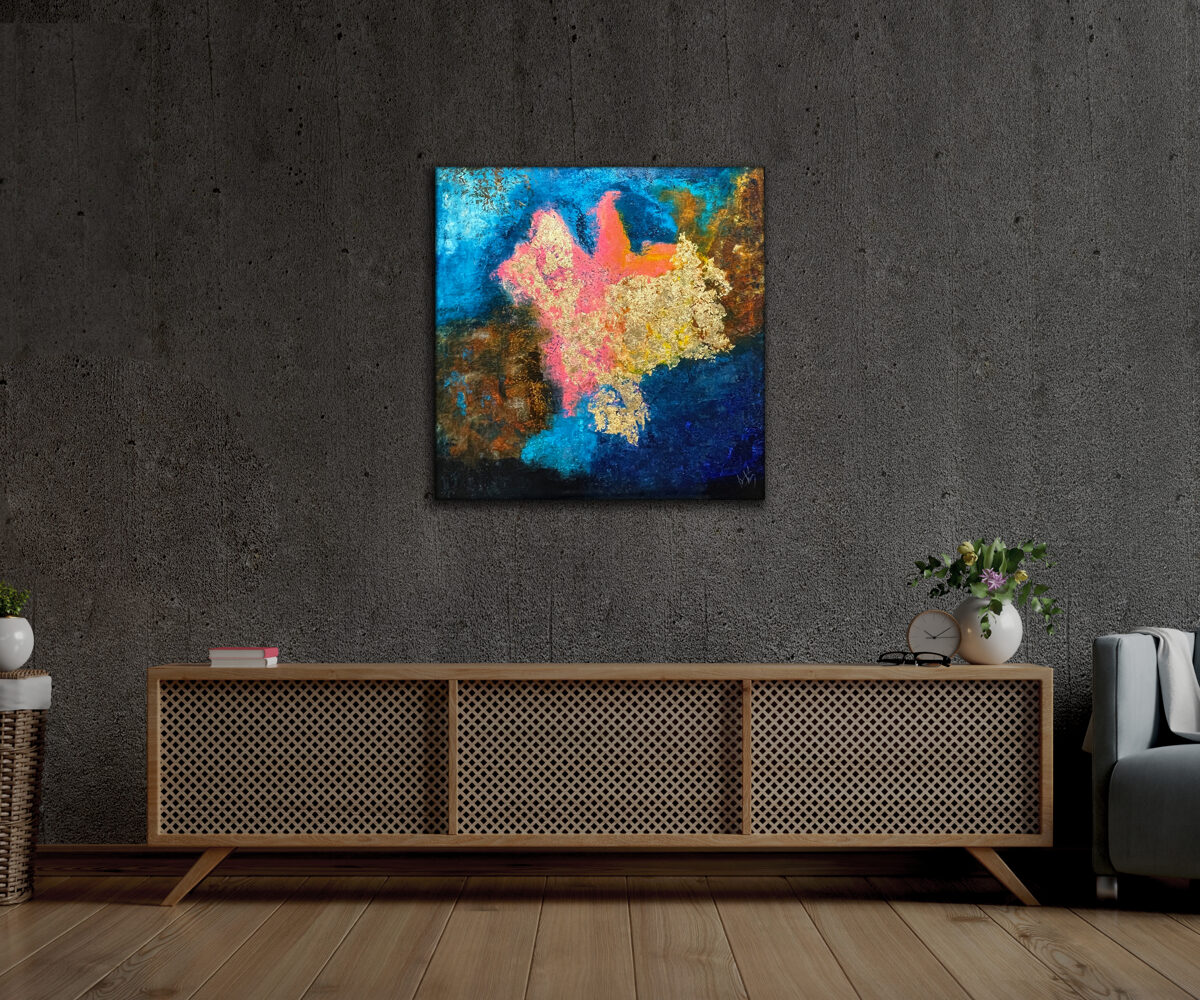
The painting entitled '‘The Other Kingdom’ in the '‘Alexander the Great – Imperator Ultimus’ series is a visual formulation of vision and the prophecy of fate: an allegory of Alexander’s spiritual turning point, who already as a child showed exceptional abilities.
On the surface of the canvas, the depth of blue, the infinity of the Universe provides the background. In this blueness, a pinkish, sometimes translucent form emerges: as if we were seeing the outlines of a map – the silhouettes of Europe and Asia appear, as promises of a world yet to be conquered. The mysterious pink glow simultaneously suggests the purity of childish dreams and the feverish desires of the growing ruler.
The golden shards and textures around this form, like a divine seal, indicate the decree of fate. Here, gold is not merely a decorative element, but the radiance of destiny: the approval of the gods, which connects continents, seas, and oceans. The golden fracture holds together the fabric of the universe, designating Alexander’s path, which goes beyond the borders of Macedonia.
The visionary quality of the painting, its opalescent, fragmented surface formation evokes the misty, yet all the more certain feeling of looking into the future. We gaze through a crystal ball as the contours almost become visible.
The story of the Delphi oracle also vibrates in the work: the young king who demands an answer, and the sentence uttered from the priestess’s lips – “You are invincible, my son!” – seems to confirm the vision. The image is thus at once past and future, childish play and imperial plan, human desire and divine prophecy in a swirling blend.
‘The Other Kingdom’ is a vision dreamed onto canvas: a world that was united by the ambition, faith, and fate of a single man, and which, even then, as a child, burned before him in his imagination - by divine decree.
13. Nausa
- 100 x 100 cm
- Oil-gold-canvas
- 2025, Sitges/Barcelona
- The artwork is part of the cycle "Alexander the Great 'Imperator Ultimus' – In Pursuit of Myths and Reality"
- SOLD

The painting titled ‘Nausa’ in this cycle evokes the sacred space of coming of age, knowledge, and friendship: the place where Alexander, under the guidance of Aristotle, embarked on the path of thought, soul, and physical fulfillment.
The canvas unfolds before us as an ethereal horizon: the symbolic bands of color depict the intertwining of landscape and sky. The opalescent pink and golden glow of the upper region suggest the subtle presence of nymphs, who, according to tradition, were the inhabitants of the sacred grove. This delicate sphericity veils the composition with a dreamlike mist: Nausza is truly the city of dreams, where spiritual and divine energies become visible at once.
In the center runs the band of the earthly world: the reddish hues highlight the granite peak rising from the picture plane, which is like the earthly embodiment of divine thought, while the greenish fields symbolize the fertility of the land and the growth of knowledge. The vertical band descending in the blue - symbol of pure water and sky - is itself the process of knowledge: the disciple’s thirst for truth, the purity of thoughts, and insight. This blue flow also alludes to the friendship between Alexander and Hephaestion: an alliance that was formed here, in the grove of the Nymphs, during their youth, and which defined them for the rest of their lives.
Throughout the painting, the duality of pastel delicacy and strong color contrasts prevails. The softness of a child’s dream world and the elemental force of coming of age are both present. This duality also foreshadows Alexander’s fate: the transformation from boy to man, from disciple to ruler, from mortal to demigod.
The ‘Nausa’ goes beyond the framework of an abstract landscape vision: it becomes a visual evocation of the sanctuary of pure thought, friendship, and knowledge. A place where, at the meeting of sky and earth, the future itself was shaped.
14. In the Footsteps of Aristotle
- 120 x 120 cm
- Oil-gold-canvas
- 2025, Sitges/Barcelona
- The artwork is part of the cycle "Alexander the Great 'Imperator Ultimus' – In Pursuit of Myths and Reality"
- SOLD
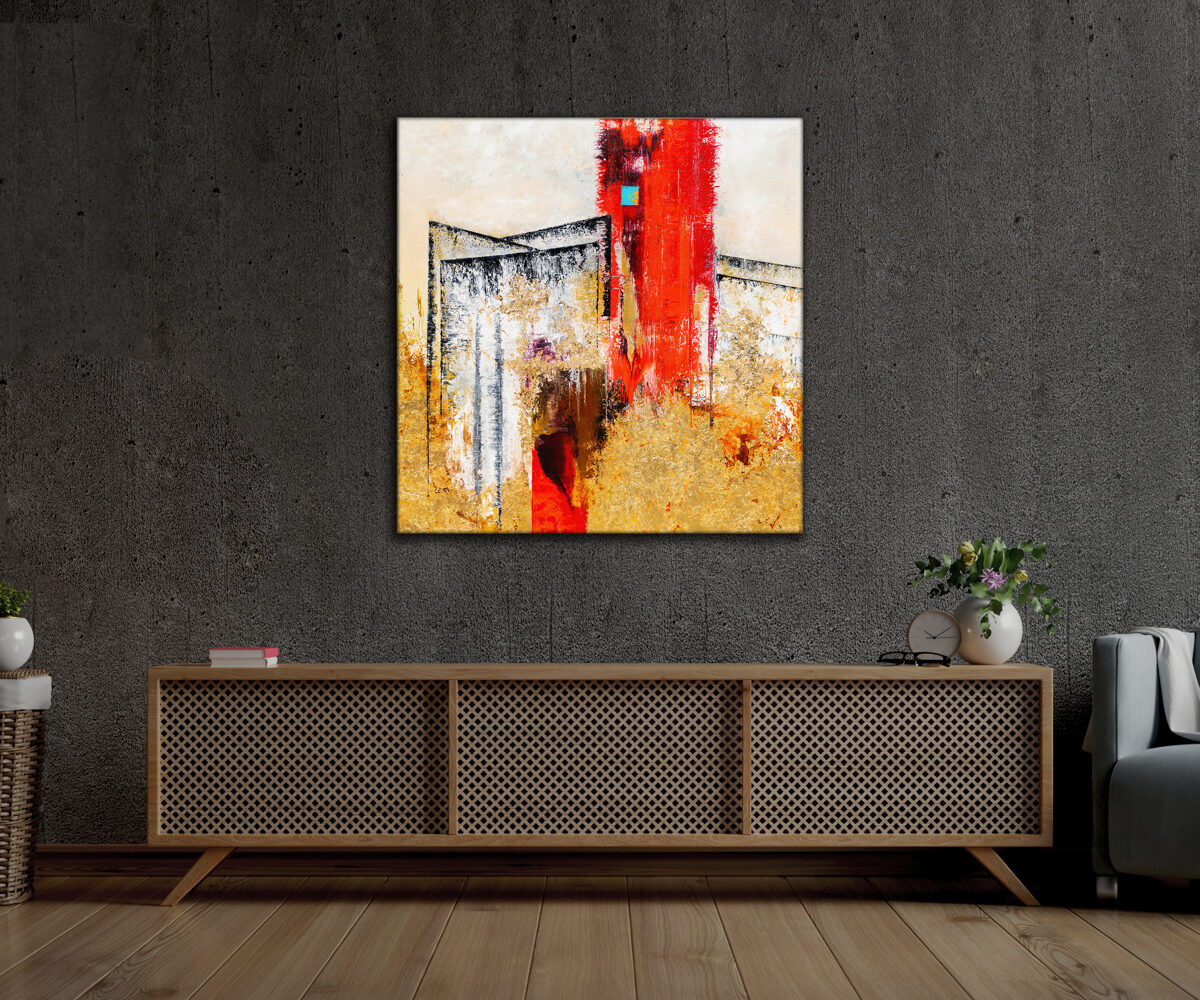
The 'painting titled 'In the Footsteps of Aristotle' is an allegory of the intellectual foundations of knowledge, logic, and conquest. It evokes not only the relationship between master and disciple, but also the intellectual heritage that became the breeding ground for Alexander’s world-shaping deeds.
At the center of the composition dominates a vertical red, force-shaping band: a flaming column that simultaneously evokes the heat of conquests and the force of Aristotle’s strict teachings. Within this red vibrates the statement: for the Greeks, a leader is needed, for the barbarians, a tyrant – a pragmatic, yet ruthless piece of advice that echoed in the decisions of the battlefields.
Behind and beside the red column, golden surfaces shine: these are symbols of the abilities given by the gods and of knowledge. Gold, as an eternal value, covers the canvas in timeless radiance, in which thoughts and divine inspiration merge into one. The surface fragmented by gold suggests: knowledge is not easily accessible, but becomes visible through struggle and the unveiling of layers.
The black and off-white line structures suggest architectural rigor: the image of a mathematical construction, a logical order emerges. These forms are symbols of strategic thinking – the foundations of tactics, foresighted planning, and psychological warfare.
The homogeneous yet vibrant space of the canvas is completed by the timelessness of quartz-like beige shades: knowledge is eternal, unchanging, and solid, like a diamond. In this structure appears one of the most mysterious elements of the painting: a tiny turquoise square hidden in the red column. This sacred sign appears here as an altar, which is the gate to the celestial world. The gold within it symbolizes turning towards the divine, the freedom and elevation of the soul.
The painting speaks at once of the discipline of human intellect and the power that comes from knowledge. The message of the picture: the exploration of the world and conquest cannot be separated – true strength of a leader lies in knowledge, which survives both time and empires.
15. The Secret of the Forest
- 68.5 x 26 cm
- Oil-gold-canvas
- 2025, Sitges/Barcelona
- This work is part of the cycle "Alexander the Great 'Imperator Ultimus' – In the Footsteps of Myths and Reality"
- SOLD

The painting titled “The Secret of the Forest” is one of the most mysterious pieces in the series: small in size, but filled with dense symbolism, it simultaneously captures the mystery of nature and the secret world of human emotions.
The canvas’s dark, deep green and bluish tones evoke an imaginary, dense forest: a shady wilderness where, after the rain, the mist is slowly pierced by rays of light. The surface still glistens with moisture, the textures vibrating with the energy that evokes the scent of the earth. Yet, in the form of a falling golden band, the light intensifies, shining through the darkness as a divine symbol.
The reddish-pink color spots in the upper left region represent the emotional dimension. These are the colors of passion, love, and secrecy, which, alongside the gold, form the other focal point of the painting. At this point, the image becomes personal: the love stories of Alexander the Great come alive. We hear the sound of footsteps among the creaking branches, as the two youths, Alexandros and Hephaistion, make their way through the forest to the tomb of Achilles, to seal their alliance – on a secret path, on a secret mission.
But one of the most important layers of the work is that the secret cannot remain hidden: the golden band, the color of divine ordination, indicates that all human feelings and desires unfold under the gaze of the divine. The darkness of the forest may protect, but the rays of light break through: there is no hiding from the eye of God.
While “The Secret of the Forest” depicts a landscape, in reality it carries multiple meanings. The alliance of human love, loyalty, and friendship is revealed against the protective backdrop of nature and divine order. It is a work that speaks quietly, in whispers, about the deepest human bonds – and about how even secrets bear their weight in the light of the universe.
16. The Seal
- 80 x 120 cm
- Oil-gold-canvas
- 2025, Sitges/Barcelona
- This work is part of the cycle "Alexander the Great 'Imperator Ultimus' – In the Footsteps of Myths and Reality"
- SOLD

The painting is an extension of the metaphor of intimacy, loyalty, and sacred love. It is not merely the depiction of a historical episode, but of a timeless gesture in which love, friendship, and divine order are intertwined in a single movement.
In the upper, opalescent region of the canvas, a globe glows in cyclamen, fuchsia, and red tones: a planet-like body, the celestial symbol of emotions. This floating sphere visibly descends from another dimension, signaling that the relationship between the two men, Alexandros and Hephaistion, has transcended the boundaries of earthly friendship and risen into the realm of ethereal love.
Below it stretches the strict horizon of gray, icy mountains. In the middle of the harsh landscape, however, a golden mountain peak rises, with a mysterious, all-seeing eye on its side: the witness of transcendence, the divine gaze before which nothing can remain hidden. This eye is the silent witness of history: the alliance of lovers is recorded not only by the earth, but also by the sky.
Golden lines rising from the foot of the mountain are the channels of divine energies: these are the threads of light moving between heaven and earth, sanctifying the relationship of the two people. These golden threads are signs of approval, the blessings of the gods.
The story preserved by Plutarch here becomes a painterly allegory: "Hephaistion at this moment holds the face of Alexander the Great in his palm, and the king seals the bond of their love with his ring, then with the touch of his lips."
The globe is the planet of passion, the mountain is the divine witness, and the threads of light are the energies of the universe that record the oath.
While “The Seal” goes beyond the symbolic depiction or abstraction of an intimate moment. Here, the seal is a universal testimony: the deepest of human relationships – no matter how secret – always stand in the light of eternity.
17. Parallel Chronicles
- 80 x 40 cm
- Oil-gold-canvas
- 2025, Sitges/Barcelona
- The artwork is part of the cycle "Alexander the Great 'Imperator Ultimus' - In Pursuit of Myths and Reality"
- SOLD

The artwork evokes the mirror play of time and history: it simultaneously refers to Plutarch's classic work and to Alexander's dual character, in which conquering force and human emotions are in tension with each other.
The composition is built on a strictly horizontal structure, as if the canvas itself were carrying two stories side by side. Above, the streams of paint cascading from purple and cyclamen evoke the elemental presence of emotions: the passion that often overruled the general's cold strategy. These colorful torrents suggest not only blood, love, and anger, but also the inner, human fragility of the historical figure.
The central golden field signals the myth of divine origin and the light of chosenness. This golden band simultaneously evokes earthly glory and the promise of eternity: Alexander's belief that his destiny was of divine origin and that he was destined to rule the world. At the same time, gold symbolizes creative power: the ability not only to destroy and conquer, but also to found and build—think of the city named after him, Alexandria, which could become the brightest center of the ancient world.
The lower region's greenish-turquoise shades evoke the world of earth and sea: the realms of conquest, those empires that came into Alexander's hands during his campaigns. The reflection and watery shimmer of the colors reinforce the idea of "parallelism": just as Plutarch placed great figures side by side, so here earth and sky, conqueror and man, divine myth and earthly reality mirror each other.
Thus, "Parallel Chronicles" functions both as a literary reference and as a character mirror: in the painting, not only does Alexander's life appear in comparison with other great figures, but also the display of his own duality. The horizontal order makes the parallels visible, while the cascade of colors reveals the dramatic weight of fate.
18. Mieza – The Temple of the Nymphs
- 100 x 100 cm
- Oil-gold-canvas
- 2025, Sitges/Barcelona
- The artwork is part of the cycle "Alexander the Great 'Imperator Ultimus' - In Pursuit of Myths and Reality"
- SOLD

The viewer stands before one of the most lyrical pieces of the cycle, namely the painting titled 'Mieza – The Temple of the Nymphs', which evokes the sanctuary of youth and the roots of the spirit.
Mieza, where the young Alexander was educated under the guidance of Aristotle, and where, alongside his friend Hephaestion, he experienced the deepest moments of childhood and youth. According to history, Mieza was not merely a school—in Plutarch's words, "the sanctuary of the nymphs"—but a grove where philosophy and nature united in mystical harmony.
Thus, the work is more than a landscape abstraction: it is also a map drawn in invisible ink of knowledge, friendship, and love.
The color scheme of the pictorial field projects this duality: the deep, lush, yet soft tones of green evoke the eternal life of nature and the invisible presence of the nymphs, while the ethereally pure surface shining on the right symbolizes innocence. Between the two, a fracture-like, vertical line runs: the entrance to the cave, that is, the mystical fissure of the nymphaeum, from where divine inspiration springs. This fracture is also a boundary: the white, pure field lies between the innocent world of childhood and the garden of spiritual, emotional, and physical awakening.
The cyclamen-colored sphere, floating timelessly in the greenish-blue space, is nothing other than the symbol of love, desire, and spiritual and emotional energies. This swirling, yet perfect, otherworldly form indicates that this was not merely a place of education: it was here that the intimate bond was woven, which connected Alexander and Hephaestion for their entire lives.
The sphere equally carries the light of knowledge and the warmth of love, the shared essence of philia and eros in the Platonic sense.
The golden spots appearing in the lower right corner evoke the memory of ancient sanctuaries and colonnades: the divine presence hidden in the heart of nature, which also enveloped the mystery of arcades and caves. This golden light is also a sacred frame.
Throughout the painting, the symbolism of colors dominates: green is life, growth, natural lushness; blue is depth and the clarity of thought; gold is divine light; and cyclamen is the hidden core of feelings. The merging layers bring back the pulsating, timeless atmosphere of the garden of Mieza.
This painting is the lyrical station of the cycle: while other works capture the fire of passion, struggle, and tragedy, here the viewer may step into the sacred place of beginnings, where knowledge and love, philosophy and youth were born together in light and shadow.
19. Kiss of Bagoas
- 80 x 41 cm
- Oil-gold-canvas
- 2025, Sitges/Barcelona
- The artwork is part of the cycle "Alexander the Great 'Imperator Ultimus' - In Pursuit of Myths and Reality
- SOLD

At the upper edge of the canvas hovers a sphere — a body aglow in shades of red, pink, and white — evoking at once the fullness of a blood moon and the trace of an intimate kiss. It is not a cold celestial orb, but a pulsating form carved from flesh, a living imprint of desire and forbidden tenderness.
This sphere is nothing less than the memory of touch, the burning seal of an encounter.
The background unfolds in deep, dark green — the tones of emerald, jade, malachite, and verdelite — layered with black, suggesting the shadow of a forest, lush and perilous in its depth. Through these layers cut streaks of white, flashes of purity and innocence. Between the two forces — the luxuriant darkness and the virginal light — tension builds, and just left of center a vertical burst of color is born, rising toward the heavens: vivid crimson, fuchsia, and gold — visual echoes of a kiss’s forbidden passion. Altogether, the composition resembles a vertical altar, upon which the sacrifice of desire and grace occurs simultaneously, ascending toward the divine.
We find ourselves in Hyrcania, where Nabarzanes — one of the murderers of King Darius — sought his own redemption through a single offering: the beauty of Bagoas. According to the sources, the young man had once been the beloved of Darius, and later of Alexander. Here the strange intertwining of mercy and passion reveals itself: Bagoas saved his former master not only with his body, but with his plea. Beneath the cruel fact of history runs a quiet yet immense force — the power of beauty, stronger than any weapon or battle.
The painting portrays, at once, a gesture of love and a knot of political, moral, and human complexity.
It commemorates a seemingly insignificant moment: the conqueror publicly kisses his slave as he would his wife. Yet the story of Alexander and Bagoas allows for a far more exalted reading — that tenderness can enter the cold circuits of power, and that in a world where empires were decided by the sword, a single kiss could alter destiny.
20. Consiliatus Imperius
- 100 x 81 cm
- Oil-gold-canvas
- 2025, Sitges/Barcelona
- The artwork is part of the cycle "Alexander the Great 'Imperator Ultimus' – in the footsteps of myths and reality"
- AVAILABLE FOR PURCHASE

The painting titled “Consiliatus Imperius” captures the duality of power and intimacy: the tension when, on the stage of history, human emotions, attachment, and beauty also take their place. It tells the story of the meeting between Alexander and his companion, Euxenippus.
In the upper region, a stream playing in sharp, strong green is descended upon by a cascade of gold: at this moment, the lights of the celestial spheres dissolve onto the earth. The greens symbolize youth and fresh strength, which can also be interpreted as a metaphor for the figure of Euxenippus, while the glimmers of gold carry the promise of chosenness – but their fragmented, dissolving light suggests that something is missing from the full radiance here.
In the upper left corner, a flaming red block pulses, capturing the gaze as a patch of passion and desire: it contains strength, light, and true charisma – all that the young Euxenippus was measured by.
In the center of the composition, a marble-like, sensually executed band runs across, bordered above and below by heavy gold inlays, framing it: a dividing line between earthly reality and relationships ordained by the sky. The gold evokes the presence of divine order: reminding us that even the most personal bonds are part of the grand tapestry of history.
In the title, “conciliatus” evokes the friend, the intimate lover, while “imperius” denotes the imperial perspective. Thus, the work connects two spheres: the public world of power and the intimate, fragile human relationships.
The canvas simultaneously evokes the personal stories hidden in the shadow of triumphs and the mystery in which history and emotion are inextricably intertwined.
20.1. The Dream of Hephaistion
- 120 x 80 cm
- Oil-gold-canvas
- 2025, Sitges/Barcelona
- The artwork is part of the cycle "Alexander the Great 'Imperator Ultimus' – in the footsteps of myths and reality"
- SOLD
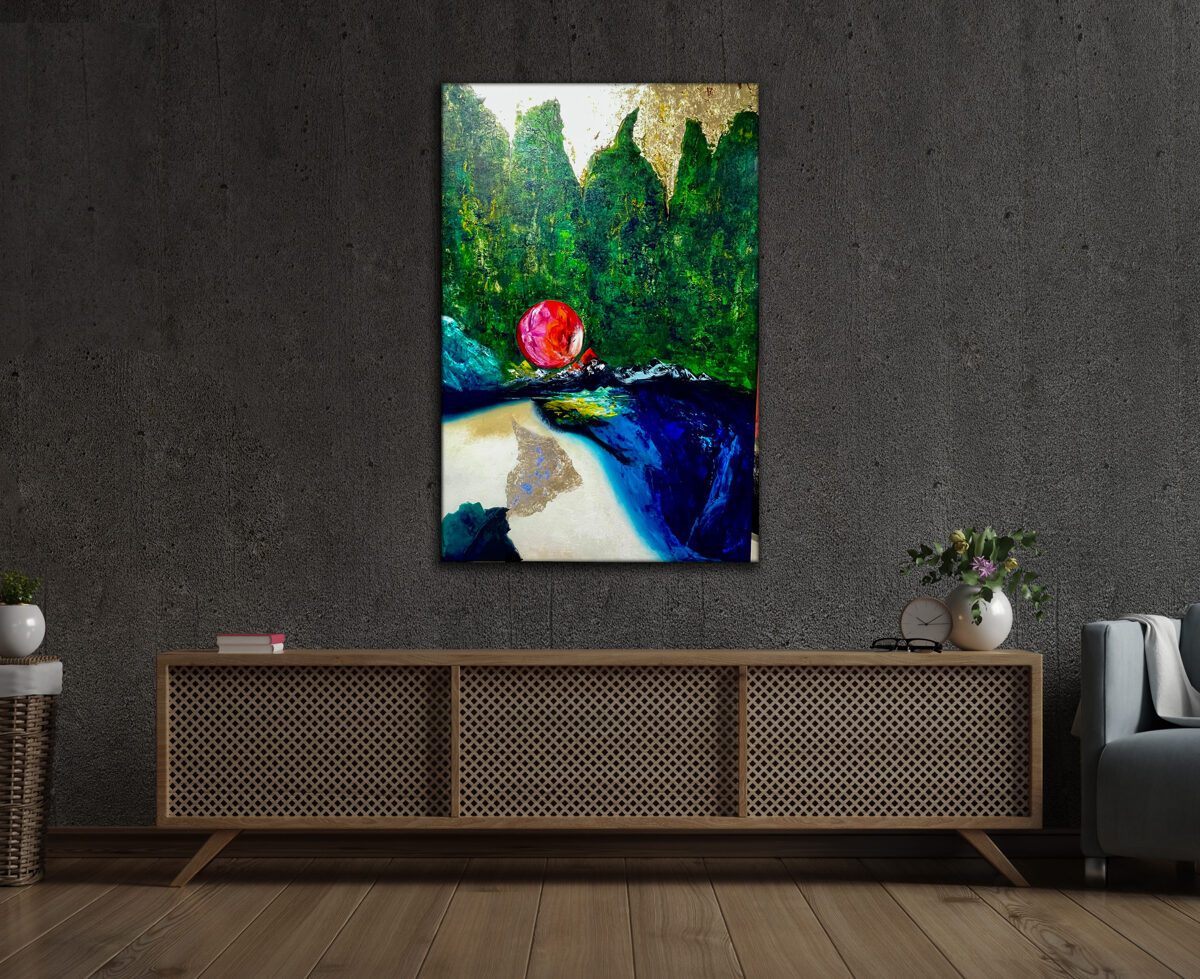
The painting titled “The Dream of Hephaistion” is one of the most mysterious pieces of the cycle: where friendship, fate, and destiny's enigmatic interweaving take visual form.
The canvas presents as a mythical vision the inner struggle that accompanied Hephaistion's youth, when his father sent him to Aristotle in Mieza to study. The motif of the dream is both a prophecy and an inner prediction, which already outlined the main stations of his life in advance: the meeting with Alexander and the tragic end brought about by Roxana's betrayal.
In the lower part of the composition, the calm of a white sea bay spreads out, a golden ray heads toward the shore as the herald of the dream, conveying the message. In the background, a rising reddish block – the mystical symbol of the Vermion Mountains – simultaneously evokes the ancient power of the earth and the foreboding of future struggles. The glowing, swirling sphere, in whose colors thousands of shades of red pulse, appears already in the dream as the fiery core of fate: a promise of a meeting, and at the same time as a symbol of destiny.
The upper region covered in green represents the boundless, almost timeless forces of nature, over which the golden radiance of light is cast. Here, the dream is not merely Hephaistion's personal experience, but a mythical vision that connects human existence with divine powers.
Thus, the painting tells of loyalty and betrayal, the purity of friendship, and the inevitability of fate. “The Dream of Hephaistion” is a vision in which the young friend does not yet know that the sphere shining behind him not only marks the most important meeting of his life, but is also the bearer of the outcome.
21. The Pillow
- 93 x 72 cm
- Oil-gold-canvas
- 2025, Sitges/Barcelona
- This work is part of the cycle "Alexander the Great 'Imperator Ultimus' – In the Footsteps of Myths and Reality"
- SOLD

The work unfolds on the borderland between knowledge and dream, where the imagination of Alexander, maturing from a child into a man, is intertwined with the teachings of Aristotle. The dormitories of the Mieza academy are both real and symbolic spaces: by day, they are the domain of strict scientific order, by night, the infinite horizon of dreams.
Aristotle, who taught philosophy, medicine, mathematics, and the arts alike, prepared his disciple's mind with all his knowledge, but the wings of imagination were unfolded by the boy himself.
The reddish-pink flowers blooming in the upper part of the canvas carry the promise of an exotic landscape. They are not merely dreamlike motifs: they are the direct forerunners of the flower field that unfolds in full splendor in the painting titled “India.” Thus, the dream under the pillow becomes a vision in which the endpoint of the later expedition—India, the mysterious East—is already latent. The close connection between the two paintings indicates: what is here only a dream and a premonition, there stands before us as fulfilled reality.
According to legend, under Alexander’s pillow rested Homer’s Iliad, with Aristotle’s notes. This book was not only a source of military virtues for him, but also a reinforcement of his longing for unknown worlds.
The golden band in the centerline of the composition is a symbol of knowledge and divine order: the spiritual heritage he received from his teacher, which later manifested in the conquests of the general.
The red field spreading below evokes the shadow of blood and sacrifice, while the green, forest-like textures arching above foreshadow the vastness of the unknown world. India still appears as a dream, but already takes shape in the imagination.
“The Pillow” is thus a double vision: the intimacy of rest is intertwined with the birth of the world-conquering plan. The recurring floral motifs in the painting titled “India” are only hinted at here, but already lay the foundation for the endpoint of the historical expedition. The child’s dream thus carries within it the birth of an empire—history is born from a dream.
22. India
- 140 x 140 cm
- Oil-gold-canvas
- 2025, Sitges/Barcelona
- This work is part of the cycle "Alexander the Great 'Imperator Ultimus' - In Pursuit of Myths and Reality"
- SOLD
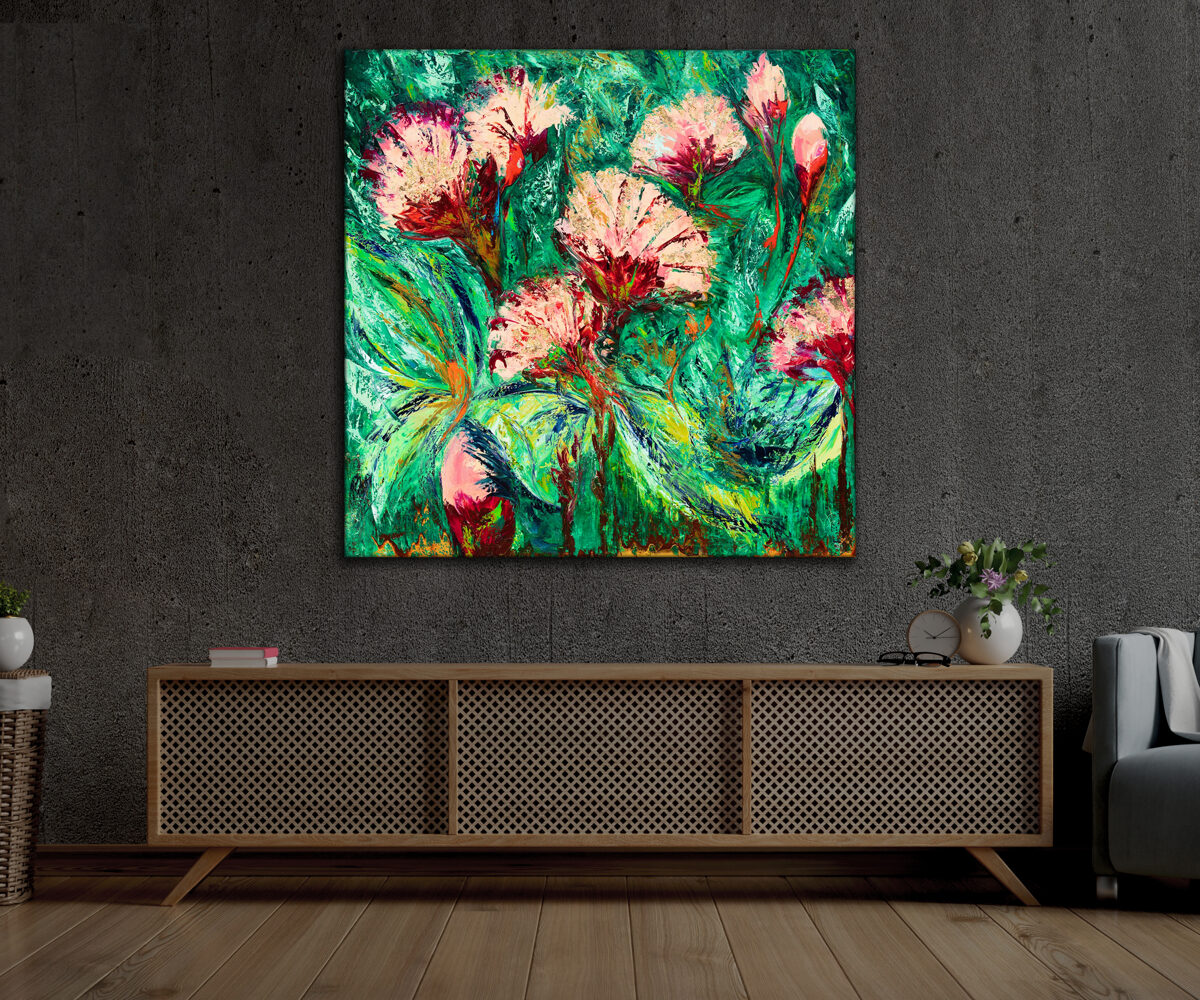
The painting titled “India” in Tamás Náray's series captures the magic of discovery and foreignness on canvas, as Alexander and his army first encounter the lushness of the eastern world. The image is bursting with color: the vibrant greens and striking pinks evoke the exuberant vegetation of the jungle, where light plays on the petals of hibiscus trees and exotic flowers. The flowers seem to explode from the plane of the painting, as if they themselves were living organisms, revealing the wonders of unknown lands to the eyes of the conquerors.
The plant forms depicted on the canvas are not only botanical sights, but also carry allegorical meaning. The petals of the orchid, shining from pink to purple and violet, symbolize beauty and fragility: they recall those moments when the chronicles of the campaign, written in blood, are interspersed with the awe-inspiring generosity of nature.
For Alexander's armies, India was both an earthly paradise and a cruel ordeal. The vibrant floral cavalcade at the center of the painting shows not only the marvel of natural abundance, but also the conqueror's fleeting peace: that state when, amidst wars, the soul finds rest in the sight of beauty.
The paradox within the work lies in the fact that while the campaign left bitter memories behind, in memory it is still the fairy-tale landscapes and flowers of India that remain. The red hues in the lower region, however, hint at the inescapable presence of sacrifice and struggle, reminding us that the price of beauty always comes with the memory of destruction.
The painting “India” is more than a depiction of a distant geographical world, it is rather an inner mirror: an imprint of Alexander's spiritual world as well, which at once thirsted for conquest and longed for the harmony of beauty. For an idealistic world, where even in the shadow of the sword, divine nature blossoms.
23. The Susa Wedding
- 100 x 100 cm
- Oil-gold-canvas
- 2025, Sitges/Barcelona
- This work is part of the cycle "Alexander the Great 'Imperator Ultimus' – In the Footsteps of Myths and Reality"
- SOLD

The duality of the work’s historical and thematic content equally captivates the viewer. From the picture field emerges an ethereal sphere resplendent in vivid colors: a flaming heart beats in the depths of infinite space, visibly carrying the bitter taste of violence and compulsion. The sphere’s purple, fuchsia, and golden hues not only symbolize the heat of desire and love, but also suppress and reject the all-encompassing greyness. The circular form, which returns into itself, here is at once the wedding altar, the sacred seal of marriage, and a symbol of a unity that is fragile, full of inner boundaries even at the moment of its birth.
About the historical background of the work: at the Susa wedding, Alexander sought to symbolically create the unity of the empire: binding himself to King Darius’s daughter, Stateira, and his soldiers to the daughters of Persian noble families.
In the abstract depiction, the background is essentially the fabric of two worlds. On the left, the grayish, faded layers evoke the harsh discipline of Macedonian order, the martial structures of Hellenic culture. On the right, dark, golden, deep brown and black colors flicker, here the imprint of the Persian court’s splendor and otherness is tense. The meeting of the two sides is not a smooth transition, but a fault line, in which behind the celebrated wedding already lies the promise of reality.
The rose quartz pigment streaks flowing down from the sphere are like the roots of new alliances, gripping the earth. Yet these colorful shreds do not strengthen, do not stand firm: rather, they unravel on the surface of the picture field. This motionless trickle symbolizes the fragile nature of marriages—that the great power play, in which Macedonian warriors and Persian princesses joined hands, in reality remained rootless.
The painting, while not telling of the triumph of marriage, but of a fragile illusion, nonetheless carries the imprint of eternal union.
Although this work is not a "festive tableau," but a pictorial record of the tragedy of a historical illusion, it nevertheless affirms true passion and love and its all-overriding seal. Thus, the flame of the sphere is nothing but the light of peace. The spreading of the dark brushstrokes speaks of the fact that there are things that are unstoppable, and this is nothing but true love.
24. The Legend of Mount Vermion
- 100 x 100 cm
- Oil-gold-canvas
- 2025, Sitges/Barcelona
- This work is part of the cycle "Alexander the Great 'Imperator Ultimus' - In the Footsteps of Myths and Reality"
- SOLD
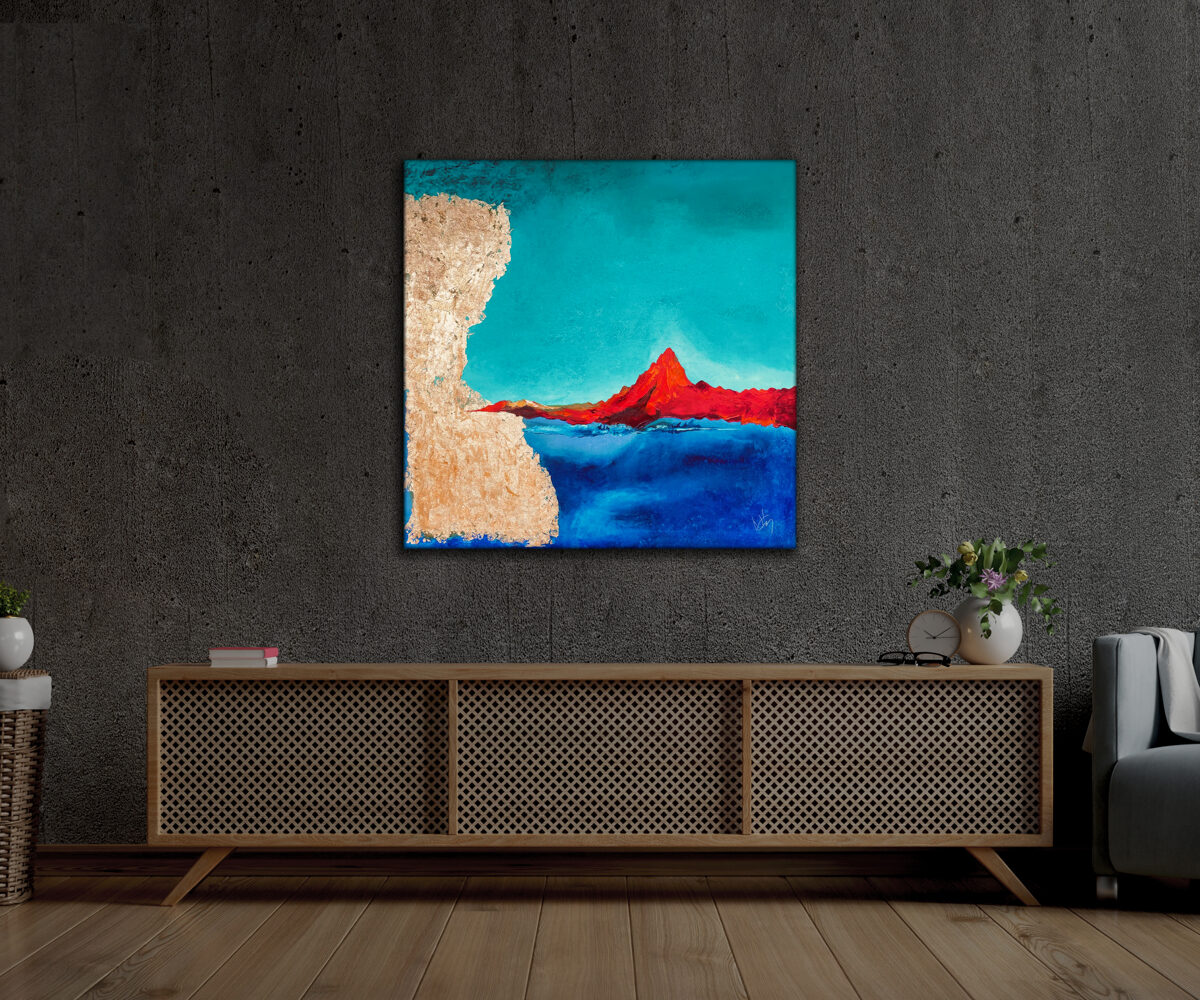
The message of the canvas is revealed to its viewer as if the imaginary, pure gold curtain of the gods had been drawn aside: on the left, the parchment-like, perforated texture falls with a metallic sheen, like a theater backdrop, from behind which the stage of myths unfolds.
In the center of the picture field, the endless blue of the sea and the turquoise glow of the sky merge, that is, the two elements of the horizon of the mortal world become one, beyond which only the realm of the gods exists.
As the focal point of the composition, the reddening peak of the mountain rises high: flaming granite, born from the womb of the planet as a mysterious shockwave: Mount Vermion, the sacred summit, which, according to ancient tradition, was raised from the depths of the earth by the hands of the gods. Its red is the color of fire, blood, and divine energy – a magical sign that promises refuge to sailors from afar, and which was sung about in the Homeric epics.
The tension created by the painterly gestures between the monumental golden band and the red mountain peak is the meeting of mystery and revelation: the artist depicts the act of passing on knowledge: for here, in the shadow of the sanctuary called Mieza, on the slopes of Mount Vermion, the academy was founded, where Alexander and his contemporaries – Ptolemy, Hephaestion, Cassander – were taught wisdom, strategy, and the conquest of the world. Thus, the mountain simultaneously becomes the source of knowledge and the symbol of power: whoever climbs to its summit is endowed with the protection of the gods.
The entire picture field is essentially a sacred stage: on the left the curtain, in the center the stage itself is the flaming mountain, and around it the infinity of the blue sky can be seen. Although the presence of the gods is not depicted in concrete form, the viewer nevertheless becomes a participant in this mystery: he feels that timeless knowledge awaits on the other side of the canvas, for those who are brave enough to reach the summit of the mountain.
The "Legend of Mount Vermion" is not merely an abstract depiction of an imaginary landscape, but a visual invocation: an allegory of the birth of Hellenism, the mystery of knowledge, and the divine touch upon human fate.
25. Beginning
- 100 x 100 cm
- Oil-gold-canvas
- 2025, Sitges/Barcelona
- This work is part of the cycle "Alexander the Great 'Imperator Ultimus' - In the footsteps of myths and reality"
- SOLD
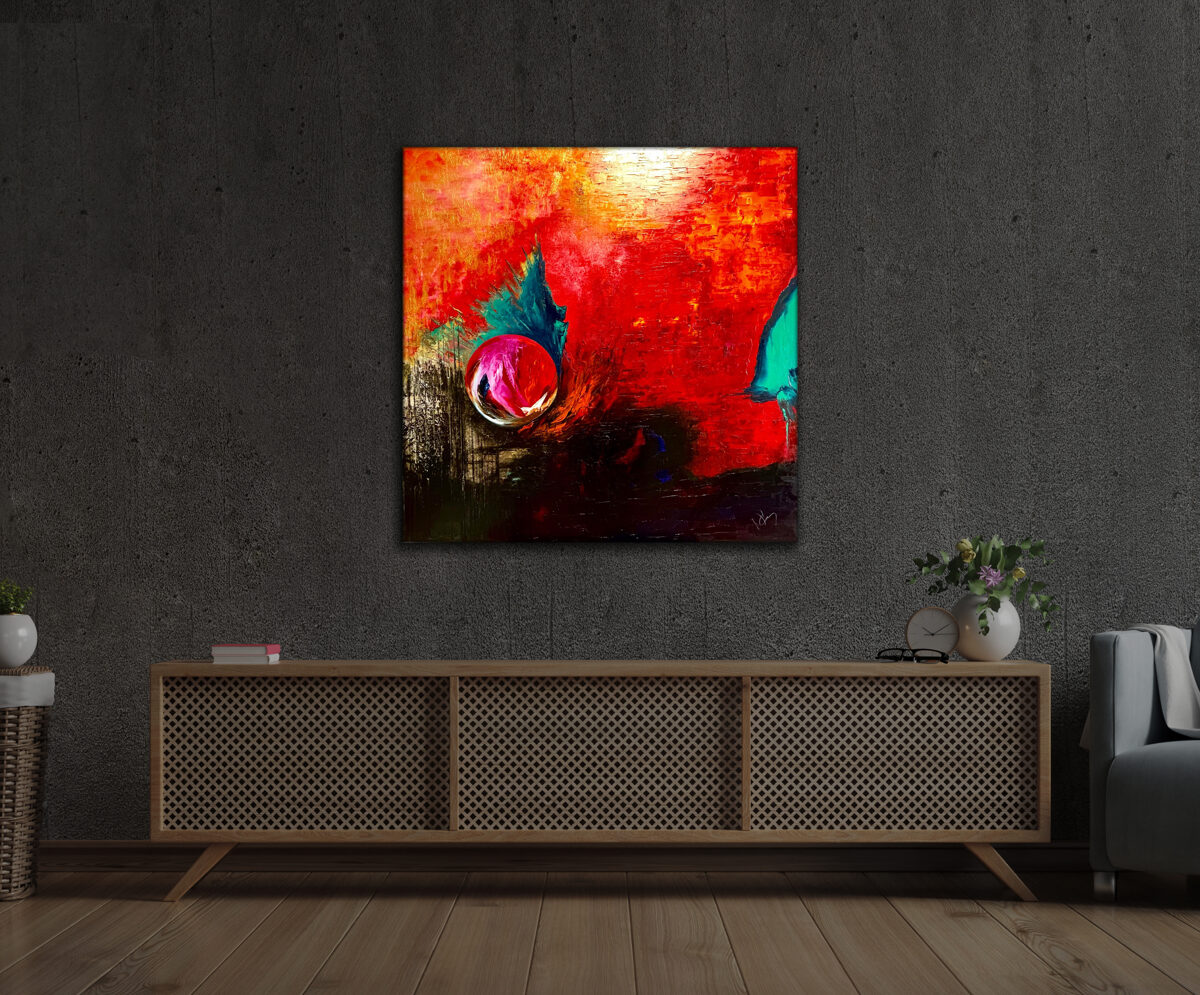
The painting titled “Beginning” stands at the inner axis of the series 'Alexander the Great - Imperator Ultimus', where the legend of divine origin gradually gives way to historical action.
The glowing sphere at the center of the canvas simultaneously carries the secret of birth and the weight of destined fate.
This motif—which also symbolizes Alexander's inner labyrinths, in the swirling of his self-reflective emotions—contains all that happened before and all that follows: Olympia's visions, the dreamlike proximity of Zeus, and Alexander's unstoppable journey across seas and empires.
The flaming background not only symbolizes the light of birth, but also those energies that already foreshadow the heat of wars and conquests. The swirling around the sphere hints at the maelstrom of the future: glory and loss, victories and sacrifices are all hidden in the almost explosive moment.
Thus, the work titled “Beginning” forms a bridge between the mythical origin story and earthly history. It depicts a transitional state, when legend slowly becomes reality, and the boy, who is still only a promise, is born as the commander who wanted to bring the world under his rule.
26. The Macedonian Ark
- 146 x 96 cm
- Oil-gold-canvas
- 2025, Sitges/Barcelona
- This work is part of the cycle "Alexander the Great 'Imperator Ultimus' - In Pursuit of Myths and Reality"
- SOLD

Not every victory leads to triumph – sometimes the course of history turns the conqueror back. In the painting, the ark does not tell of advance, but of forced return: of the moment when Alexander no longer controls fate, but becomes a passenger within it. The river’s current sweeps him away, the blazing shores are left behind, and before him appears a golden, yet at that time still uncertain, future.
The red block evokes the passion of the rebellious army and the sacrifices: the anger of the soldiers who, halted on the banks of the Hyphasis, broken by the monsoon rains, immeasurable losses, and the endless Indian landscape, rebelled against their ruler. The wall of flames on the left of the composition marks the irrevocability of this point – from here there is no further, here the road ends that would have led to the edge of the world.
The square, bronze-golden motif floating in the center clearly symbolizes the ark: a fragile yet divinely radiant symbol that bears the decree of fate. The blue and green tones of the water represent the river’s current, the irresistible force of time and history – the necessity that not even a world conqueror can resist.
On the right, the golden field bathed in light signifies both hope and doom. The path of the Macedonian ruler’s return, which closes the Indian campaign, but opens a new era in the Hellenistic world. The mountain-like blueness of the rocks sets up gates: the exit from India, which cannot be fully conquered, only touched.
While the painting recalls a historical event, it also presents a kind of metaphysical lesson: the ark floats on the boundary between human will and divine order. Although Alexander reached the edge of the world, he ultimately became a passenger on the ark of fate, which led him back from the flames of conquest into the light of passing away.
27. Entry into Babylon
- 120 x 120 cm
- Oil-gold-canvas
- 2025, Sitges/Barcelona
- The artwork is part of the cycle "Alexander the Great 'Imperator Ultimus' – In Pursuit of Myths and Reality"
- SOLD

When Alexander's army entered Babylon, one of the greatest turning points in history unfolded. The painting recalls this moment not through the brutality of battle, but through the intertwining of creative and earthly order. In the upper left corner of the composition, the swirling blue “wheel of time” represents the celestial sign, the lunar eclipse, which the Persians saw as fate, while Alexander interpreted it as divine justification. The diverging rays project the divine decision across the entire canvas, marking the inevitable path of conquest.
In the lower regions, the tension between red and blue evokes the Battle of Gaugamela. Red symbolizes blood and loss, while blue this time carries the calmness of strategy and the purity of victory. Yet the masterfully painted, overflowing tones with the palette knife suggest peace, as if the noise of struggle had faded, replaced by the tranquility of order.
The golden field unfolding on the right recalls the gates, wealth, and peace of Babylon. The sacred light seems to dissolve the tragedy of war, and the motif of the Ishtar Gate symbolically opens the way before the ruler hailed as “King of Asia.”
Seemingly, the picture is about a station of conquest: it tells of that rare historical moment when the greatest victory was achieved with the fewest sacrifices. Seeing Babylon's dazzling wealth and its people, Alexander showed mercy: he left everything untouched. Thus, the work tells of the coincidence of worldly triumph and the fulfillment of divine order.
28. Before the Walls of Babylon
- 100 x 81 cm
- Oil-gold-canvas
- 2025, Sitges/Barcelona
- This work is part of the cycle "Alexander the Great 'Imperator Ultimus' - In the footsteps of myth and reality"
- SOLD

The crimson height, rising above the shadows of the night, symbolizes those unfulfilled plans that still burned in Alexander's mind, even as his strength was already waning.
The vertical axis of the composition – the white sacred column – splits the space, drawing a boundary between sky and earth, between human will and divine judgment. Once, Alexander was king of a world surrounded by gold, but now the ethereal space itself becomes the initiator of new creation.
The red rectangle, the unshakable crimson altar, stands at the center of divine will.
Before the walls of Babylon, Alexander saw not only his own mortality, but also the future.
Thus, the gold-black-red dialogue of the canvas becomes a memento: we are all but travelers among the walls of history.
29. The Preserving Grace
- 60 x 60 cm
- Oil-gold-canvas
- 2025, Sitges/Barcelona
- The artwork is part of the cycle "Alexander the Great 'Imperator Ultimus' – In Pursuit of Myths and Reality"
- SOLD

30. In the Protection of the Sun
- 92 cm ⌀
- Oil-gold-canvas
- 2025, Sitges/Barcelona
- The artwork is part of the cycle "Alexander the Great 'Imperator Ultimus' – in the footsteps of myths and reality"
- SOLD

The circular shape of the canvas itself carries a sacred meaning: it appears before the viewer as the symbol of eternity, completeness, and the divine cycle. Within this universal frame unfolds the composition, which is at once earth, fire, and celestial radiation—that is, all elements of the world are united within it.
At the center of the rustic textures, the blaze of red and gold dominates, as if the Sun God himself had stepped forth from the depths of the canvas. The fiery red background evokes not only the heat of battles or the blood of human sacrifice, but the divine presence that elevated Alexander above all human fate. The blue streak crossing the color is the water found in the desert, the path of existence and purification, which, splitting in two, reveals the radiant shape of the “Golden Mountain”—the sanctuary standing on the border of myth and reality, where Hephaestion and Alexander sealed each other's fate.
The dialogue of opposites can be grasped in the painting: the ecstasy of red and the calm of blue, the earth’s dark-toned body and the divine decree descending from above as gold. This dramatic tension evokes Alexander’s inner quest: the general who shattered empires here reveals himself before the Sun God.
The painting preserves the secret of the Siwa oasis: the moment when a mortal man is elevated to divinity. The protection of the Sun is not merely a blessing, but an empowerment: it makes the son of Amun-Ra part of the divine order ruling the world.
Thus, the circular shape of the canvas is not only a frame, but also a cosmic seal: the fate marked out by the Sun God, which forever closes around the figure of Alexander.
31. Crossing the Bosphorus Delta
- 60 x 60 cm
- Oil-gold-canvas
- 2025, Sitges/Barcelona
- This work is part of the cycle "Alexander the Great 'Imperator Ultimus' - In Pursuit of Myths and Reality"
- SOLD

The work titled ‘Crossing the Bosphorus Delta’ at first glance presents us with the triumph of light: the golden-yellow shining horizon glows above the bay, the shimmering layers of blue and gold paint scatter the rays of the midday sun onto the water. Yet in the lower region of the image, a blood-red, vertical cascade of paint bursts forth as a dramatic contrast – bringing the shadow of history into this radiance.
This is the moment when Alexander crossed the Bosphorus Delta to conquer Constantinople. Behind the city walls, the memory of Constantine the Great is still preserved – the exceptional emperor, who gave the city its name, and who, according to legend, was related to Alexander's mother. Porus, the conqueror's comrade-in-arms, friend, also came from here. Perhaps because of these ties – and perhaps also listening to divine inspiration – the conqueror spared the inhabitants of the city. The blood-red streak of paint, which does not reach the golden horizon, here does not refer to destruction, but to the nuanced tension of life preserved: to the mercy that dances on the edge of the sword.
The duality of the composition – the radiant sky and the foreground soaked in red – evokes the nature of power: the eternal alliance of glory and danger, light and blood. The golden surfaces and the rustically applied red textures together create the living fabric of history, in which the moment of conquest pulses forever.
32. Alexander and Poros
- 100 x 100 cm
- Oil-gold-canvas
- 2025, Sitges/Barcelona
- The artwork is part of the cycle "Alexander the Great 'Imperator Ultimus' – In Pursuit of Myths and Reality"
- AVAILABLE FOR PURCHASE

Some triumphs are not fulfilled in the destruction of the defeated; sometimes the true brilliance of victory shines in the recognition of the greatness of the other person.
After the battle fought along the Hydaspes River, Alexander stood above his opponent not only as a general but as a demigod: Porus, the brave and steadfast Indian king, was not destroyed, but, his dignity preserved, was raised beside him.
The fiery reds of the canvas evoke the heat of battle, the fierce struggle soaked in blood and sweat. The golden streams emerging from the blazing colors open up another dimension: the flow of divine energies that guided Alexander's decision. Poros appears as a gray, rocky mass: immovable, proud, his strength not broken even by defeat.
The square appearing on the right side of the composition, symbol of altar sanctity, points toward royal dignity and divine order: the seal of the shared historical fate of victor and vanquished. The golden band dividing the horizon highlights the relationship between the two rulers: Alexander's gesture by which he preserved Porus's life and throne, thus giving him a place forever in the pages of history.
While the painting, with dramatic gestures, tells of the triumph by the Hydaspes, it also tells of the two faces of human character: one is the merciless conqueror, the other the king capable of respecting greatness. This duality is what raises Alexander from a famous general to a myth-making force.
33. Forgiveness
- 100 x 100 cm
- Oil-gold-canvas
- 2025, Sitges/Barcelona
- The artwork is part of the cycle "Alexander the Great 'Imperator Ultimus' – In Pursuit of Myths and Reality"
- SOLD

On the pages of history, generals most often write their names in blood, destruction, and vengeance, but sometimes a single gesture – mercy – echoes more powerfully than the greatest victory.
In front of the walls of Babylon, at the gates of the world's richest city, Alexander made a decision that went beyond the laws of warfare: he spared the city and forgave its defender, Mazaeus.
The painting's glowing reds and golden radiance evoke the triumph of conquest and the splendor of Babylon, yet at the center of the image stands a cold, bluish river. This river separates the victor from the vanquished, mercy from vengeance. As if the water showed the path to reconciliation, capable of cooling burning passions.
On the horizon, the distinctive peak of Mount Vermion appears as a shadow, recalling Aristotle's teachings: respect for life.
However beneath the seemingly calm surface, magma smolders: wounded dignity, the pride of the victor, and the fear of the defeated. The tension of the painting is born from this duality: the illusion of calm and the inner, seething fire are both present.
The dark blocks on the left bring the shadow of danger: they remind us that forgiveness is never the same as forgetting. The boundary between victor and vanquished is as fragile as the meeting of cold blue and glowing red in the painting.
The artist's image asks whether mercy truly builds a bridge, or merely places a temporary shackle on hatred.
Alexander's forgiveness of Mazaeus was a gesture of exemplary value, yet knowing human nature, the question remains: can a true ally ever be made from an enemy?
34. Roxana
- 100 x 100 cm
- Oil-gold-canvas
- 2025, Sitges/Barcelona
- This work is part of the cycle "Alexander the Great 'Imperator Ultimus' – In Pursuit of Myths and Reality"
- AVAILABLE FOR PURCHASE

This extremely complex work is a dramatic milestone in the 'Alexander the Great – Imperator Ultimus' cycle: for it captures not only a moment in the life of Alexander, but also the ancient archetype of the female fate: the eternal intertwining of love and death, desire and destiny.
At the same time, the work visualizes an emotional triangle, evoking both a love drama and a sacred iconography: the painter elevates earthly emotions to the level of timeless myth. The triangle does not close, but remains open – indicating that the dynamics of relationships never found peace, and ultimately ended in tragic closure – and with this triangle symbolism, the work represents not only Roxána, but also unfolds Alexander's emotional universe: the eternal tension between the three peaks of passion, friendship, and power.
In the upper register, the yellowish-golden horizon and the swirling bright sky above suggest a promise, a hope – Roxána's fate at first truly carried the promise of triumph and ascent. The Bactrian girl, whose beauty became legendary, captured Alexander's heart: in their marriage, East and West, the Macedonian and Persian worlds, were united.
Yet the essence of the painting is not hidden in the horizon, but in the darkening chasm of the center, which refers to the depths of the female principle. This black space, which the artist boldly evokes as a symbol of femininity, refers equally to the source of life and the vortex of destruction.
A mother, with the possibility of life, also gives the inevitability of death.
In the figure of Roxána, fertility, love, and tragedy are embodied at once. The life-giving mother who brought Alexander IV into the world, and at the same time the woman who was ultimately imprisoned and murdered – thus she herself became a kind of sacrificial cave, the scene of life and death. Yet this darkening depth carries not only Roxána's physicality, but also the dark, jealousy-laden side of the relationship. Around her pulse reddish, crimson tones: the flames of love, signs of Alexander's devotion. This red, however, is not uniform: sometimes it shines, sometimes it fades, showing the pulsation of passion and uncertainty.
Among the reds and blacks, turquoise spots cut through, like celestial lights flashing into a wound: they symbolize both the brief flare of hope and the merciless turns of fate, but also connect to the spiritual and emotional presence of Hephaestion. The cold lights evoke not only rational thinking and the companionship of a general, but also the timeless purity of the intimate bond between men.
In Roxána's story, power and love formed a fatal mixture: the initial divine gift ultimately became the prey of political intrigue and the power struggles of men.
The color scheme of the painting – the passion blazing in red, the danger plunging into dark depths, and the gold hinting at the promise of the horizon – summarizes an entire life story. Black and red – Roxána: physicality, passion, jealousy; turquoise – Hephaestion: friendship, spiritual community, purity; and gold – Alexander: the king, torn by the two forces, while his own fate is also driven toward destiny.
Thus, the figure of Roxána is not only a historical character, but also an archetype: beauty that elevates and leads to ruin; the mother who gives and loses life; the queen who embodies both triumph and destruction.
35. The Capture of Thebes
- 80 x 80 cm
- Oil-gold-canvas
- 2025, Sitges/Barcelona
- This work is part of the cycle "Alexander the Great 'Imperator Ultimus' - In Pursuit of Myths and Reality"
- SOLD

There are cities that live on not only in their stones but also in their legends – Thebes was such a place. One of the most magnificent settlements of the Greek world, built from white limestone and colorful, pastel-glowing basalt ornaments: a radiant city that was once the land of heroes.
But when Alexander stood before the city to persuade them to join the Corinthian League, the Thebans turned against him, seeing the Persian ruler as the guarantor of their freedom.
The painting's blazing red sky seems to echo Plutarch's words: “even the sky blushed red from the blood of the Thebans”. The lower white band suggests the city's innocence – the purity of that uniquely cultural center among the poleis, which, though militarily weaker, still steadfastly resisted the Macedonian king. In the middle of the canvas, the upward-breaking forms evoke two building complexes: the fortress of Kadmeia and the house of Pindar – the two structures that, by Alexander’s command, were spared from destruction.
The tension between the glowing red and the dazzling white is not merely the drama of destruction and innocence. The duality also contains political calculation: Thebes served as a deterrent example to all other Greek cities. The cruel bloodbath thus became a strategic tool, which Alexander later used with cold rationality during his Persian campaigns.
While the picture seemingly preserves the memory of a tragic destruction, it also holds the weight of that historical moment when the fall of a city opened a new era in world history. The tragedy of Thebes thus became the symbol of the Macedonian ruler’s merciless exercise of power – and the eternal question: does glory always lead through destruction?
36. Alexander in Gordium
- 50 x 50 cm
- Oil-gold-canvas
- 2025, Sitges/Barcelona
- This work is part of the cycle "Alexander the Great 'Imperator Ultimus' – In Pursuit of Myths and Reality"
- SOLD

This small-sized painting is one of the most powerful and dramatic pieces of the cycle, in which the meeting of myth and history erupts as geological forces on the surface of the canvas.
The composition is dominated by a sharp blue and black stripe running down the center of the picture plane: the sky and earth split apart to reveal divine judgment.
This chasm is nothing other than the visual metaphor of the Gordian knot – the inextricable tangle, which Alexander's intellectual strength and strategic ingenuity unraveled, not by the legendary sword stroke, but by understanding divine mysteries.
The ocher, brownish, golden, rock-like structure on the left recalls the Phrygian past: Gordias, the peasant chosen to be king, the fulfillment of the divine prophecy by the decision of the priests. Here, gold is the sign of chosenness, the sacred promise, through which Sabazios, that is, the Phrygian Zeus, shines. The fiery red, flaming patch of earth on the right signals Alexander's energy, the heat of his future conquests: from here begins the empire that, by the will of a single man, will stretch over Asia.
The work simultaneously bears the marks of drama unfolding in both earthly and cosmic space. The clash of colors and textures evokes a sky torn by lightning: it is no coincidence that, according to legend, Zeus confirmed his satisfaction with thunder and lightning after the knot was solved.
Here, divine will and human determination become one: under the brush of Tamás Náray, the moment appears when the threads of fate converge in the hands of a single man. The contrast of red and gold carries the promise of future conquest, while the whitish grayness is the scene of timeless prophecy. Before the viewer's eyes unfolds that mythical moment when a man became a ruler – and which forever changed the fate of the world.
"Alexander in Gordium" is not a simple historical illustration, but an archetypal vision: an allegory of overcoming the impossible.
37. Lord of the Seas
- 80 x 80 cm
- Oil-gold-canvas
- 2025, Sitges/Barcelona
- This work is part of the cycle "Alexander the Great 'Imperator Ultimus' - in the footsteps of myths and reality"
- SOLD

The canvas reveals the gateway to a mythical universe: golden celestial rays plunge into the infinite depths of the water. Divine will transforms the history of the mortal world. The flowing golden stream simultaneously evokes sacred intervention and the pathos of victory.
The vision is dominated by a symphony of countless shades of blue – from the dark, ominous tones of the sea's depths to the translucent turquoise of the waves. The golden fragments embedded in the blue – like the impregnable walls surrounding the island – represent both the city of Tyre and the titanic power of nature. The borderline stretching between water and gold is the causeway itself, built by the Macedonian army: a passage stretched by human will between myth and reality.
The upper, gold-dissolving band evokes the celestial dimensions from which Poseidon – lord of the seas – lifts the causeway with a single gesture to aid the lord of the lands, Alexander the Great. The ripples of the waves seem to carry the Macedonian army on their shoulders, breaking through from the depths of the blue into the realm of legends.
This work, on the occasion of a historical moment, also depicts the iconic moment of alliance between nature and man. That instant when the world conqueror realizes that his empire can only be fulfilled with the approval of the gods.
The composition floats before our eyes as an eternal sea vision on the border of myth and history.
38. The Crown
- 80 x 80 cm
- Oil-gold-canvas
- 2025, Sitges/Barcelona
- This work is part of the "Alexander the Great 'Imperator Ultimus' - In Pursuit of Myths and Reality" cycle
- SOLD

The artwork, through the image of a royal attribute—the crown—becomes an allegory of an era. The process of power and glory, drowned in gold yet doomed to destruction, appears on the canvas.
The dazzlingly radiant gold texture dominating the surface at first glance evokes the brilliance of conquests—the crown that, with an iron will, subdued the world. But upon closer inspection, the cracked, crumbling surface is already the harbinger of decline: the glory slowly worn down by time and human suffering.
At the top of the composition, dark, jagged forms tower like blackened mountain peaks or burnt towers, between which red cascades descend. These red streaks—bold and uncompromising gestures—evoke the price of conquest: human destinies pulsing behind every triumph. The dramatic contrast of the deep blue sky and the black mountain range amplifies the weight of the image, as if the sky itself were witness to the crown's fall.
On Tamás Náray's painting, created with a special technique, we can observe masterful brushwork and refined use of the palette knife: sharp, dripping contours erode the noble surfaces.
Besides recording the transience of power, the work also conveys a timeless truth: only that remains above which is not born from the suffering of others. “The Crown” is both a historical monument and a moral warning—a memento sealed in gold that prompts the viewer to self-reflection.
39. Entry into Heliopolis
- 100 x 100 cm
- Oil-gold-canvas
- 2025, Sitges/Barcelona
- This work is part of the cycle "Alexander the Great 'Imperator Ultimus' – In the Footsteps of Myths and Reality"
- SOLD

The golden opal-like radiance of the canvas brings to life the Egyptian sunlight – that blinding, all-pervading brilliance that has shown the holy city of Heliopolis as the home of the Sun God, Ra, since the dawn of time.
The painting's facture evokes the testimony imbued in the sandstone, the indestructible temple walls, and the sky-piercing obelisks: those glorious layers of history upon which now the figure of Alexander is cast.
The black-and-white stripe on the left, as an archaic seal carved in relief, signals the shadow of Persian rule: the past, which now recedes into the background, and whose cracking imprint counterpoints the golden monumentality of the image. From here, the gaze moves toward the central, colorful signs – symbolic coronation rituals, which under the painter's brush almost become emblems.
The blood-red, pulsating brushstrokes in the golden field evoke the festive moment of Alexander's proclamation as pharaoh: the paradox of conquest without battle, where the sword is replaced by ceremony.
The emerald green gesture that shines in the golden space of the canvas is the eternal sign of being raised as the son of Amun-Ra – the symbol of divine initiation, which placed the Macedonian conqueror among the pharaohs.
The yellow, golden stripe unfolding toward the right depicts the rays of the sun, and, like the Sun God himself, seals Alexander's fate.
The tension between colors and textures – the vivid red, the gemstone green, and the shining gold in dialogue – conveys the drama and solemnity of the historical act.
The painting is both the chronicle of the entry and the visual hieroglyph of that moment when Alexander – the conqueror, the general – crossed into the realm of myth, and was no longer just a ruler, but became an initiated and consecrated pharaoh as the son of the Sun God.
40. Persia
- 100 x 100 cm
- Oil-gold-canvas
- 2025, Sitges/Barcelona
- This work is part of the cycle "Alexander the Great 'Imperator Ultimus' - In the footsteps of myths and reality"
- SOLD

At first glance, the canvas captivates the viewer: the dazzling brilliance of gold dominates the space, and the myth of the empire rises before us. This all-encompassing, timeless light evokes the wealth and power of the Persian Empire, which was once the world's largest dominion. The vastness of Egypt, Syria, Asia Minor, Mesopotamia, and present-day Iran all merge in this golden glow, truly revealing the texture of eternity.
The deep red stripe symbolizes the price of blood that this power has paid again and again. This band not only carries the memory of wars and battles but also of sacrifice, which is inscribed in the fate of every great empire. Next to it, the flash of turquoise evokes Egypt and the Nile, the life-giving river that was at once a road, a border, and a divine symbol.
Tamás Náray's work presents the essence of his exceptional gilding techniques. The cracks executed on the gilded surfaces, the so-called "aging" effects, and the opalization of the brilliance with pigments all reveal a prepared, masterful knowledge.
The painting takes us back to the era of Darius: to the heyday of the empire, when aqueducts, temples, and writing systems were born, when soldiers crossed on pontoon bridges to conquer new continents. Yet, here and there, the gold surface already cracks and wears away, and the subtle shadows of transience penetrate the all-encompassing splendor.
And then Alexander steps onto the stage, crossing the Hellespont to confront this world bathed in light. The spoils, the treasures, the capture of Darius's family all symbolize the transfer of power. But Tamás Náray's canvas does not merely evoke history: the eternity of gold proclaims the immortality of the Persian Empire, which, though it fell, will forever remain in the collective memory of humanity.
This image, alongside the conquests, shows that empires are not only political entities but also the fabrics of culture, knowledge, divine power, and immortality, which shine through all ages as golden light.
41. The Legend of Darius
- 90 x 60 cm
- Oil-gold-canvas
- 2025, Sitges/Barcelona
- This work is part of the cycle "Alexander the Great 'Imperator Ultimus' - In Pursuit of Myths and Reality"
- SOLD

The pure, golden radiance of the canvas dazzles the viewer at first glance – the opulence and wealth of the Persian Empire unfolds before us.
Yet this all-encompassing light is not uniform: its surface is cracked, rippling, restless, with the premonition of downfall throbbing behind the glory. This duality of gold reflects Darius’s situation: his power seems unshakable, yet it is subjected: Alexander’s armies are advancing.
The three black bands at the bottom of the painting, like stations, recall the stages of the story. The first is wealth: the promise of ten thousand talents of gold, which embodied Darius’s intent to negotiate. The second is the empire: the ceding of territories west of the Euphrates, by which the Persian king sought to relieve himself of the burdens of further war. The third is his daughter’s hand: the promise of a dynastic alliance, which became the most intimate gesture of humiliation.
Yet these three bands symbolize not peace, but rather the Macedonian conqueror’s path to victory. Alexander’s words – “If I were Parmenion, I too would accept the money!” – are clearly outlined in the strict, layered black motifs of the composition: instead of peace, total domination; instead of compromise, the choice of divine decree.
In the upper, golden field, delicate mauve shades evoke the grandeur of existence in the empire, which lay behind Darius’s offer. The vibration between purple and gold keeps the viewer on the borderline between the divine and the human: did the offer promise peace, or would it have only led to further war?
The work tells both of legend and reality: of Darius’s generous offer, Alexander’s unyielding response, and of that historical moment when, on the border of two worlds, it was decided that divine will guided the hand of the Macedonian king.
42. The Awakening
- 100 x 120 cm
- Oil-gold-canvas
- 2025, Sitges/Barcelona
- This work is part of the "Alexander the Great 'Imperator Ultimus' - In Pursuit of Myths and Reality" cycle
- SOLD

At first glance, the artwork suggests peace: a soft, opalescent sky, the silvery silence of mountains on the horizon. But this calm is deceptive. The golden central band of the painting, spreading out like a divine beam of light, does not merely carry beauty—but the dawn moment of a story. This is the moment when, after a mortal wound and a week of complete unconsciousness, Alexander slowly regains his breath. The whispers of the afterlife accompany his return to existence: the command of the gods to subjugate Constantinople before he closes his eyes again.
On the right side of the painting, the city silhouette built from black and red shades is already Constantinople itself—a fortress shrouded in shadow, yet still radiant, which is both a promise and a threat. The red spots, like blood-soaked seals, mark the price of the mission—conquest is never pure. The cold blue and gray tones emerging from behind the mountains carry the frozen silence of the hero's past, while the golden field represents the ecstatic yet fleeting light of rebirth.
This painting both commemorates the power of human will and warns of the weight of missions: ascension is never free from loss, and the divine message is not one of peace, but of trial.
“The Awakening” is thus not only a historical scene, but a visual hymn to the eternal duality of power and mortality.
43. The Voice of Time
- 92 cm
- Oil-gold-canvas
- 2025, Sitges/Barcelona
- This work is part of the cycle "Alexander the Great 'Imperator Ultimus' – In the Footsteps of Myths and Reality"
- SOLD

At first glance, the work depicts the sparkling light of the sun disk, from which a golden column rises, like a divine revelation on the scorched field of battle. However, much more appears on the canvas.
The circular form embodies eternity, the straight lines intersecting the upper plane in a wedge shape evoke the endless cycle of time, in which the decision of the moment seals destinies.
In the composition, the yellow radiance, creating the illusion of scorching heat, covers everything, while the column standing in the center – like an axis clad in gold – rises as a sign of the transcendent, blinding the opponent, but showing the way to those who dare to hear the Voice of Time.
The reds and blacks dominating the lower region carry the harshness and cruelty that test man in battle, while the geometric spatial elements and angular forms refer to the cold, calculated existence of Darius's empire. The blue, definite, living elements, on the other hand, open up free expanses: they bring the promise of the sky, the eternity of triumph into the composition, as if divine providence itself had created space for Alexander's victory.
The painting does not depict the spectacle of struggle, but that mysterious moment when, in the flow of history, Time speaks: dazzlingly, mercilessly, and unmistakably.
This circular canvas is also the icon of time: an eternal reminder that the moment of victory is not sealed by man, but by the Voice of Time.
44. The Pilgrimage
- 100 x 81 cm
- Oil-gold-canvas
- 2025, Sitges/Barcelona
- This work is part of the cycle "Alexander the Great 'Imperator Ultimus' - In the footsteps of myths and reality"
- AVAILABLE FOR PURCHASE

In the painting titled “The Pilgrimage”, the canvas itself becomes a stage where myth and history intertwine.
Alexander’s journey to the Siwa Oasis is not simply a geographical movement, but a sacred crossing, a transition of human fate towards divine order. At first glance, the fragmented, restless surfaces of the painting speak of this transition: the red tells of the heat of struggle and the torment of the body, the yellow of the promise of divine light, while the whitish, rock-like base evokes the timeless face of the eternal, solid desert.
The black, downward-dripping lines bring the experience of the nearness of death, the exhaustion of the body, and the uncertainty of existence close to the viewer. As if the canvas itself were drying out, crumbling, like the lips of a wanderer in the hot sand. And yet: the darkness does not engulf, but leads through – serving as a gate, behind which shines the golden light of the Sun God, the goal, the promise of initiation.
In the pilgrimage, reality and vision, human weakness and divine support intertwine. There are no sharp boundaries in the painting either: the colors blend, flow, and blur into each other. This dissolution is itself the sacred experience, where man loses his earthly coordinates to find his place in the order of the gods.
Thus, “The Pilgrimage” becomes an allegory of perseverance and inner strength: for Alexander – and for every viewer – the message of the journey is that the greatest victory is not the conquest of the world, but the discovery of harmony between oneself and destiny.
45. Way to Amon
- 50 x 50 cm
- Oil-gold-canvas
- 2025, Sitges/Barcelona
- This work is part of the cycle "Alexander the Great 'Imperator Ultimus' - In the footsteps of myth and reality"
- SOLD

The viewer stands in the blinding light of the desert: the scorching gold and glowing yellow layers stretch the space of the painting: the heat of the endless road leading to the Siwa oasis radiates through it. The golden surface embraces the unfolding forms at the center as a divine aura.
In the heart of the composition, a black, vertical shape breaks forth, rising fearsomely like temple gates into the radiance. The dark masses of the sanctuary columns evoke the tormenting difficulties of Alexander's journey: besides the trials of the body, the shadow of inner uncertainty, the net of agonizing doubt, through which he had to pass to reach the oracle of Amon.
This darkening shadow is cut through by a red and a cobalt blue, powerful painterly gesture. The blood-red symbolizes the crimson altar, the color of power and sacrifice, given to the conqueror by the high priesthood. The blue is almost metallic, otherworldly in its brilliance: the seal of heavenly legitimacy, sacred rule.
Together, these two colors embody the mystery of the ritual – the meeting of earthly and divine power.
The white band illuminating the top of the composition represents the radiant light described by ancient sources: the indisputable proof of divine presence. The merging of gold, red, blue, and black is nothing but the imprint of the birth of a new identity, the process of becoming a son of god from a human.
This painting is not simply a historical pilgrimage but the story of the deepest initiation: the moment when the Macedonian king faces the mystery of his own origin, and when, in the scorching gold of the desert, in a new body is born as “son of Zeus,” that is, in Egypt, “son of Amon-Ra.”
46. Sanctuary of Amun-Ra
- 50 x 50 cm
- Oil-gold-canvas
- 2025, Sitges/Barcelona
- This work is part of the cycle "Alexander the Great 'Imperator Ultimus' - In Pursuit of Myths and Reality"
- SOLD

The painting titled “Sanctuary of Amun-Ra” is the imprint of the initiation mystery, guided by visions. It is not just a historical reference to Alexander’s journey to the Siwa Oasis, but also a staged evocation of the transcendent encounter: the moment when the mortal becomes the son of the Sun God.
The gold-woven surfaces of the painting evoke the vibrant energies of divine presence, which envelop the conqueror like invisible, impenetrable fields. The radiant semicircle appearing in the lower left of the painting is a sun disk, from which golden rays – like laser beams – burst forth, traversing and slicing through the composition. These lines simultaneously evoke the brilliance of sacred light and the ecstatic force field of initiation.
The chalk-colored and soft aqua-green bands are symbols: the limestone-like whiteness recalls the marble slab of the sanctuary, where the conqueror begins to awaken after his initiation, while the lagoon-green shade brings the water of life, rebirth. The black and gold cracks symbolize the trials of initiation: the tensions of the human body and soul, without which the divine connection could not be established.
The tension present throughout the canvas – the fragmented structures, the violent breakthrough of the rays – nevertheless merges into harmony in the all-encompassing radiance of the golden wing motifs. Thus, the painting becomes an allegory of sacred transformation: here Alexander is not only a conqueror, but a being who accepts his divine sonship, ascending to the truth of a higher order.
The term “sanctuary” designates not only a space, but also an inner state: the encounter with the eternal God, in which the king becomes a sacred ruler and the mortal becomes the bearer of divine will.
47. In the Shackles of Emotions
- 100 x 140 cm
- Oil-gold-canvas
- 2025, Sitges/Barcelona
- This work is part of the cycle "Alexander the Great 'Imperator Ultimus' - In the footsteps of myths and reality"
- SOLD
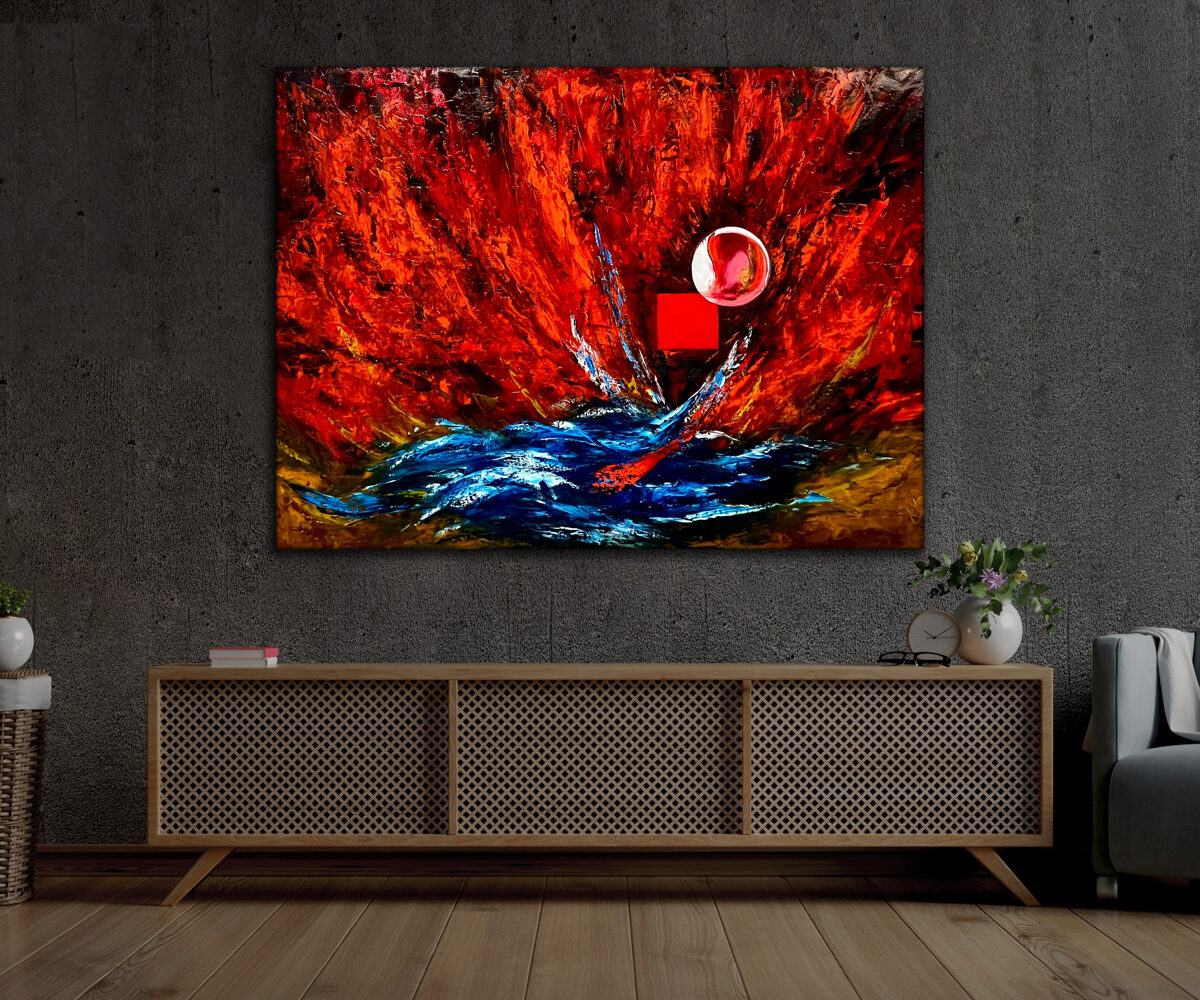
In the painting titled "In the Shackles of Emotions," Tamás Náray reveals the human face of the conqueror, the tyrant who rules with consuming fire, who is at once vulnerable, driven by desires, and at the same time a prisoner of his own passions. From the canvas, it is not the victorious, triumphant commander who looks back at us, but the man torn by inner contradictions, who tries to conquer himself by conquering the world.
The blazing red of the picture field symbolizes the soul's constant, inextinguishable fire: a devouring sea of flames in which the intoxicating fervor of glory and the torment of destructive doubts are both present. The cobalt blue-marsh green-bark brown structure appearing in the lower region of the picture field evokes the various stations of earthly existence: seas, battles, loves, escapes—all that bound the Macedonian ruler to the world of the body and history.
The red square, the motif of the altar, almost sinks beside the vibrant, fuchsia-toned planet—this is the planet of emotions, symbolizing the heart's agitation, the unstoppable and uncontrollable surges of desires and attachments. Thus, the painting tells not only of the conqueror's external world, but also of his inner universe: of the man who, from his ambivalent relationship with his mother to the burdens of his loves and friendships, felt shackled throughout his life.
The vibrant colors and powerful gestures contain the duality that also defined Alexander the Great: the cruel butcher and the merciful man, the tyrant and the devoted lover, the earthly commander and the divine son. The energies bursting from the canvas speak of an endless inner struggle, of the fire that consumed him every day, yet made him strong and memorable.
Every movement of the painting recalls the words of Plutarch: “Alexander loved on earth as God loves in heaven.” A conqueror who in reality remained a prisoner of his own heart. A mad dreamer, son of Zeus, who at once fled from and was drawn to the flame that ultimately consumed him.
48. The Legacy
- 100 x 120 cm
- Oil-gold-canvas
- 2025, Sitges/Barcelona
- This work is part of the cycle "Alexander the Great 'Imperator Ultimus' - In Pursuit of Myths and Reality"
- SOLD

The painting titled “The Legacy” is already one of the images of closure: the final, symbolic summary of a life's work and an era. Here, the work does not show the heat of conquest, nor the intoxication of victories, but the duality of permanence and transience.
At the center of the composition, the dark block actually depicts the silhouette of a ship's hull, which simultaneously refers to the arduous journey of earthly existence and to that eternal journey on which every human being – even a ruler considered of divine origin – must travel.
The ship emerging from the mist, as if rising from various buildings: the non-earthly bearer of the soul. A strong vessel, which, although battered by the relentless storms of history, still sails with straight and proud masts on the horizon of the infinite blue. On the crossbars of the masts, in place of the tattered sails, the crimson-red altar shows the divine ordination along which the ship ultimately travels.
The golden veil of the picture field recalls the divine origin of Zeus's son – the rays of the Sun God illuminate the space of creation. Gold simultaneously evokes glory and the illusion of transience: what is tangible crumbles, but the spiritual light shines forever.
The deep blue sea symbolizes the infinity of human existence, that all-consuming, timeless medium in which only the traces of heritage may remain.
The red square emerging from the dark structures of the hull is the sanctity of the altar, the ultimate measure: the only point entitled to pass judgment over a person's – a conqueror's, a son of god's – earthly deeds.
Yet the peculiar tension of the canvas dissolves into peace: gold and blue, the transient and the eternal, the earthly and the divine meet within it. “The Heritage” thus is not only the epilogue of Alexander the Great’s story, but an allegory of the eternal question of every human being: what do we leave behind when the body crumbles, but the spirit lives on?
49. On the Last Day
- 120 x 100 cm
- Oil-gold-canvas
- 2025, Sitges/Barcelona
- The artwork is part of the cycle "Alexander the Great 'Imperator Ultimus' – in the footsteps of myths and reality"
- SOLD

The painting stands on the axis of two worlds in tension with each other: the golden and luminous architectural fragments on the left evoke the order of earthly civilization, the glory of already conquered empires, while the deep red and cobalt blue bands on the right conceal the dark oceans of unknown, as yet unexplored timelines.
At the center of the composition, almost hidden, the tension of the figure standing half-turned is palpable. The arc flashing out from the red paint avalanche—the Sun’s protective shield, which is in fact nothing other than the symbol and energy core of infinite, self-returning time—marks the condensed moment of future and past.
Here, Alexander the Great is no longer the victorious general, but the traveler who knows that by stepping beyond time, every battle, every glory falls into the obscurity of the past. The transition between the golden left side and the blue right side is dramatic, almost apocalyptic. This is the moment when one of history’s greatest figures understands: there are no more conquests, only the last journey—along the cracked spatial lines cutting diagonally across the space, which are at once bridge and axis between timelines—back to where he started, before his Creator, his gods. His mission is completed.
This painting is not merely a pictorial record of “the last day,” but a cosmic closing chord: the single tense, weighty silence of man and time’s infinity frozen into a moment.
50. The Gate
- 146 x 96 cm
- Oil-gold-canvas
- 2025, Sitges/Barcelona
- The artwork is part of the "Alexander the Great 'Imperator Ultimus' - In Pursuit of Myths and Reality" cycle
- SOLD
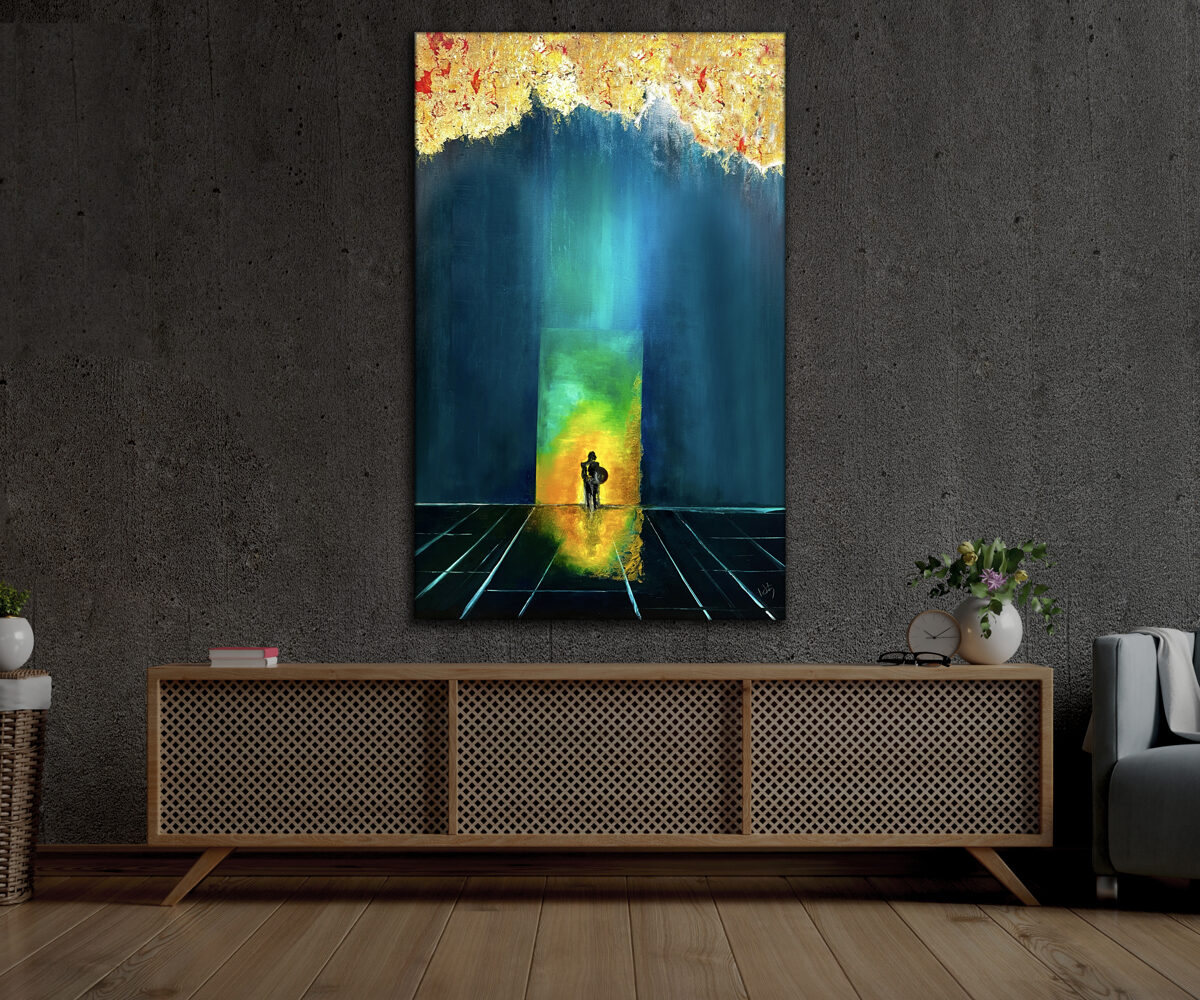
“The Gate” is the finale of the Alexander the Great - Imperator Ultimus' series, or the climax of the story, where conquests, dreams, and victories fade, and only one question remains: what awaits on the other side?
Tamás Náray’s monumental painting is not only about Alexander the Great’s last moment, but also about that eternal human experience that catches up with every mortal.
The vertical axis of the canvas reveals a gate of light, a symbol of the transcendent dimension. The ethereal radiance, the gold and yellows swirling in a thousand shades, represent the divine force itself: this dynamic gesture permeates every vibration of the space. The metallic cloak of the upper region, where at times the crimson-red altar color seeps through, descends like a baldachin, evoking the presence of the creator. The deep green and the mysteriously opening bluish background stand in strong contrast, evoking the realm of earthly existence from which the hero finally steps out.
The solitary figure – Alexander the Great – stands as a tiny silhouette in the cosmic light before his creator. Behind him, the gates of history have already closed, and before him now the gate of eternity opens. On his arm still hangs the shield, the attribute of protection and battle – but now, before the final crossing, it is more a burden than a strength. The shield on the hero’s weakening arm reveals that even the greatest conqueror is human, his journey is finite, and like every son of man, he too fears the unknown.
The reflections of light on the floor suggest duality: they evoke both the glitter of earthly triumphs and the promise of otherworldly lights. The immeasurable monumentality of the space, the fragility of the figure, and the dramatic harmony of the colors all emphasize: greatness ultimately turns into solitude; at the Gate, everyone must cross alone.
The concluding work of Tamás Náray’s series is not merely the closure of the series, but also a universal allegory. The gate – the boundary between existence and death, the earthly and the divine – is the fate of every human. Thus, through the story of Alexander the Great, Náray’s work evokes humanity’s oldest question: what awaits us on the other side, when the sluice behind us closes forever?
51. The Conquest of Byzantium
- 120 x 100 cm
- Oil-gold-canvas
- 2025, Sitges/Barcelona
- The artwork is part of the "Alexander the Great 'Imperator Ultimus' - In Pursuit of Myths and Reality" cycle
- SOLD

The artwork is a painterly metaphor for the encounter, merging, and struggle of civilizations and belief systems, where colors and textures condense a complex drama onto a single plane.
The composition’s two poles – the golden-red on the left and the part dissolving into blue shades on the right – separate two worlds: the earthly and the celestial realms, Western and Eastern spirituality, the earthly brilliance of power and the infinite horizon of faith. The motif of the red crescent is not blood, but a symbol of strength, will, and the desire for conquest. This crescent wedges itself between the sea and the city, floating in the whirlpool of history as a dual symbol of power and faith.
The golden stripe on the left evokes the golden column reaching to the sky, which, according to tradition, was erected by Constantine the Great in the heart of Byzantium, later Constantinople, proclaiming the splendor and divine legitimacy of the imperial city. Here, gold evokes the city’s brilliance, glory, and spiritual light, but at the same time carries the metallic shine of transience – that light which can illuminate just as much as it can blind.
The blue surface on the right, the merging and almost infinite expanse of water and sky, evokes Byzantium’s geographical and spiritual position: the city that stood on the border of two worlds, washed by both the sea and the waves of history. In this movement, in the current of the water, time itself seems to dissolve – Byzantium’s past, Constantine’s god, and the ideals of later conquerors all blend into a single blue radiance.
Thus, “The Conquest of Byzantium” is not an illustration of a historical event, but a visual allegory of the end of an era and the beginning of a new world. The painting does not speak of violence, but of transformation – of how faith, power, and beauty become a single spiritual energy that again and again takes shape in human history.
Cart
Cart is empty.
